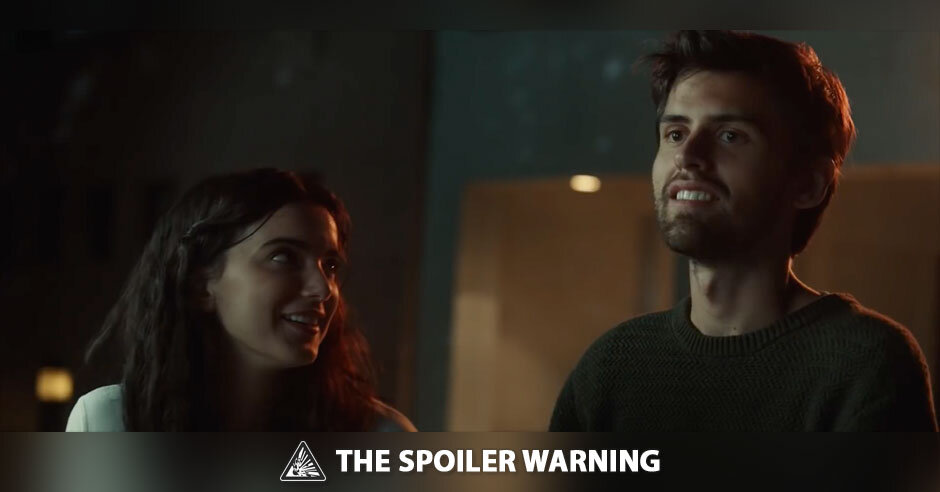
Cut to the chase: Want to see this year’s actual list? Head over to Decoding Everything.
Previous write-ups: Check out the last decade of end-of-year lists to get a sense of our similarities and differences.
Podcast: You can listen to my straightforward Top 10 list on The Spoiler Warning.
Introduction
I have a tradition of tallying my favorite films of the year and turning them into an essay for my blog. But for the last few years, I’ve been honored to contribute that essay instead to David Chen’s Decoding Everything newsletter. If you haven’t already, you should read it first: It’s a significantly more polished (and complete) encapsulation of my thoughts about the year in cinema.
Still, for the sake of continuity, I always like to post a little something extra for readers of my blog and/or this Substack. Last year, that came in the form of an Appendix. This year, I thought I’d shift gears and talk about tomorrow’s Academy Awards—and, in the process, give one last “hurrah” to the many films I loved.
For each category, I’ll share three opinions: which nominee will win, which should win, and what alternatives should have been nominated in their place. Because I think it’s only fair to judge categories I have some personal experience with, I’m going to omit a few:
- Animated Short Film, Documentary Short Film, and Live Action Short Film. I didn’t manage to catch any shorts this year, so for those of you making a prediction bracket of your own, I suggest you give it a Google!
- Documentary Feature. I only caught up with one of the nominees, No Other Land. It’s a phenomenal doc, and I’m personally rooting for it to win! But I can’t honestly judge it against a slate I haven’t seen.
- Music (Original Song). I’ve seen two of the four films nominated, and in the case of Emilia Pérez, I forgot the songs roughly 30 seconds after they stopped playing. On the one hand, it would only take me ~15 minutes on Spotify to rectify this problem and be a completist. On the other: This category is garbage and I don’t care who wins.
OK, now on to the awards!
Animated Feature Film
- Flow
- Inside Out 2
- Memoir of a Snail
- Wallace & Gromit: Vengeance Most Fowl
- The Wild Robot
What will win? If you’d asked me to predict this category a few months ago, a low budget Latvian film with zero dialogue, little exposition, and an intentionally stripped-down aesthetic wouldn’t have been high on my list of contenders. But awards voting bodies continue to surprise me this year, and by all indications, Flow is going to take home the prize.
What should win? In terms of quality, it’s a tie for me between Memoir of a Snail and Flow. Both are excellent. But for its sheer audacity (and what this win means for the category moving forward), I’ve got to give an edge to Flow.
What should have been nominated instead? This was a fairly weak year for animated features. Setting aside Robot Dreams (which was already nominated last year), the only three I loved (Flow, Memoir of a Snail, The Wild Robot) are already represented in this category. No notes!
International Feature Film
- Emilia Pérez
- Flow
- The Girl With The Needle
- I’m Still Here
- The Seed of the Sacred Fig
What will win? If not for the train wreck of negative publicity, Emilia probably would have had this in the bag. But I think even the stubborn, Bohemian Rhapsody and Green Book-adoring factions of the Academy know a lost cause when they’ve seen one. Whereas I’m Still Here continues to have a groundswell of support. It catapulted seemingly overnight from being a film many American critics hadn’t seen, to being a serious contender in multiple categories. It also happens to be excellent, and has no serious detractors to my knowledge. I think this is Walter Salles’ award to lose.
What should win? I think Flow, The Girl With The Needle, and I’m Still Here would all be worthy wins. But The Seed of the Sacred Fig is my personal favorite, both as a standalone work of art and as a potent political statement. Mohammad Rasoulof and his cast fled Iran in secret to attend the Cannes premiere, and cheering for them as they entered the Palais remains one of my most moving moments of 2024.
What should have been nominated instead? Payal Kapadia’s All We Imagine As Light was one of my favorites of the year, and it’s a shame India didn’t submit it for consideration. Likewise for Poland and Green Border, a powerful work of docu-fiction which couldn’t be more timely given current anti-refugee sentiments and the recent change of tune regarding the Russo-Ukrainian war. Sub out Emilia Pérez (a movie I didn’t hate but certainly don’t think belongs in serious contention: You can listen to my scatterbrained thoughts out of Cannes) and The Girl With The Needle (a powerful, brooding arthouse drama which I liked just a tad less than the others).
Visual Effects
- Alien: Romulus
- Better Man
- Dune: Part Two
- Kingdom of the Planet of the Apes
- Wicked
What will win? I haven’t been following any of the buzz when it comes to these technical categories, so take all of these predictions with a grain of salt: I don’t know anything you don’t know. But I’d wager this is a dead tie between Dune: Part Two and Wicked. Going to give the edge to Dune: Part Two as a consolation prize for not winning much else.
What should win? I haven’t seen Better Man, but I have seen the other four, and think Dune: Part Two is the most deserving among them…with Kingdom of the Planet of the Apes just a smidge behind it. (The Robbie Williams biopic looks great, for what it’s worth, but it’s hard to imagine anyone out-CG-aping that franchise.)
What should have been nominated instead? It’s outrageous to me that the best action spectacle of the year, Furiosa: A Mad Max Saga, isn’t getting a single awards nod. Drop Alien: Romulus and give something to George Miller’s epic.
Sound
- A Complete Unknown
- Dune: Part Two
- Emilia Pérez
- Wicked
- The Wild Robot
What will win? Same disclaimer as above regarding technical categories. I imagine Dune: Part Two has a solid shot here, and can also see a strong argument for A Complete Unknown given how vital diegetic music is to its success. But I think Wicked takes this as a last minute sub for Emilia Pérez.
What should win? The Wild Robot is an inspired nomination for this category. It’s less flashy in its use of sound than the other picks, but it’s the film whose sound design I find most personally memorable.
What should have been nominated instead? Again, Furiosa: A Mad Max Saga should be sweeping these technical awards. Drop Emilia Pérez to make room for it.
Costume Design
- A Complete Unknown
- Conclave
- Gladiator II
- Nosferatu
- Wicked
What will win? I wouldn’t be at all surprised if Wicked took the prize, and it would be a deserving victory. But I suspect the same voting bloc that swoons for Elizabethan period pieces and royal regalia will go all in on Vatican chic. I’m calling this for Conclave.
What should win? There are few categories I feel less opinionated about than Costume Design. But I found Nosferatu’s period aesthetic very striking, and a big part of that comes down to costuming.
What should have been nominated instead? I can’t say I know precisely where costumes end and makeup begins, but I Saw The TV Glow nails both in its eerie recreation of the 90s Nickelodeon look and feel. I’m as enchanted by Greenwich Village as anyone, but for the sake of variety, I’d let Mr. Melancholy and his minions bump out A Complete Unknown.
Makeup and Hairstyling
- A Different Man
- Emilia Pérez
- Nosferatu
- The Substance
- Wicked
What will win? It’s hard to imagine the Academy resisting the charms of Wicked. She’s green, for Pete’s sake! And it’s a metaphor for racism and other stuff, probably!
What should win? This is a stacked category, and there’s a decent argument for every nominee: Even Emilia Pérez, the punching bag of this year’s awards season, uses makeup and hairstyling in a way that is crucial to the story. But for me, it comes down to the two body horror flicks. While The Substance was the better film in my opinion, A Different Man is the one which lives or dies by its precise use of makeup. It nails it.
What should have been nominated instead? Even though I defend Emilia Pérez in this category, its inclusion is inextricably linked to its clumsy, ultra-binary handling of trans identity. Why settle for clumsy, when I can nominate a far better film about the trans experience which happens to have incredible hair and makeup? Give its spot to I Saw The TV Glow instead.
Production Design
- The Brutalist
- Conclave
- Dune: Part Two
- Nosferatu
- Wicked
What will win? None of these nominees would surprise me with a win, but I think Wicked is going to take it given the sheer scale of its production.
What should win? All five films impressed me with their production design (especially Nosferatu), but only one pulled it off on a shoestring budget. The Brutalist is the most deserving of the bunch, and doubly so when considering the constraints they managed it under.
What should have been nominated instead? I’m going to sound like a broken record, but I adored the look and feel of I Saw The TV Glow. It’s hard to cut anything in this category, but I’d lose Conclave as a matter of personal preference. It does an admirable job of recreating the Vatican; I’m just not as thrilled by it.
Music (Original Score)
- The Brutalist
- Conclave
- Emilia Pérez
- Wicked
- The Wild Robot
What will win? Normally I’d be inclined to bet on Wicked here, but I suspect the Emilia Pérez stragglers will split the musical vote. So instead I’m going with Volker Bertelmann’s excellent score for Conclave.
What should win? Bertelmann’s work on Conclave is great, as is Daniel Blumberg’s for The Brutalist. But by my memory, Kris Bowers’ score for The Wild Robot blows the competition out of the water.
What should have been nominated instead? The total lock out of Challengers from this year’s awards ceremony is bizarre, and nowhere is it more glaring than in the Original Score category. Trent Reznor and Atticus Ross not only should have been nominated; they should have won. Other highlights were All We Imagine As Light (particular Topshe’s song which closes the film, though I’m unsure where “score” ends and “soundtrack” begins when it comes to original compositions) and Alex Somers & Scott Alario’s ephemeral Nickel Boys score. Lose Wicked, Emilia Pérez, and (gun to my head) Conclave to make room for these.
Film Editing
- Anora
- The Brutalist
- Conclave
- Emilia Pérez
- Wicked
What will win? Judging by its awards season momentum, I think this is Anora’s to lose.
What should win? I’ve gotta go with the consensus here: Sean Baker’s linear editing process is vital to the momentum of his films, and he knocked it out of the park with Anora.
What should have been nominated instead? Count this among the multiple categories which Nickel Boys ought to have won by a landslide: Nicholas Monsour’s elliptical, rhythmic editing is crucial to the film’s artistic success. Also throw in Challengers for those heart-pumping tennis sequences. No hard feelings, Emilia Pérez and Wicked.
Cinematography
- The Brutalist
- Dune: Part Two
- Emilia Pérez
- Maria
- Nosferatu
What will win? Voters will be captivated by the way Greig Fraser managed to turn Dune: Part Two into Lawrence of Arabia, but ultimately I think they’ll give this to Lol Crawley for The Brutalist. The ingenuity of filming in VistaVision is sure to win over film nerds everywhere, and the end product looks like a (couple hundred) million bucks.
What should win? Count me among the hypothetical nerds. Of these options, The Brutalist feels most deserving.
What should have been nominated instead? It’s a travesty that Nickel Boys wasn’t nominated for the one category it seemed like an obvious lock to win. Jomo Fray’s first-person filming technique is every bit as clever as Crawley’s bag of tricks, and carries far more emotional weight: This movie is a miracle, and it lives or dies by its cinematography. I can’t rightly drop Maria because I haven’t seen it, so here again I’ll settle for kicking out Emilia Pérez.
Writing (Original Screenplay)
- Anora
- The Brutalist
- A Real Pain
- September 5
- The Substance
What will win? Screenplay awards tend to function as a consolation prize for smaller films. Normally, a Sean Baker indie or offbeat Brady Corbet epic would seem like perfect candidates. But this is a strange year, and Anora and The Brutalist are anything but underdogs. Instead, I think the Academy will award Jesse Eisenberg for A Real Pain.
What should win? If my prediction pans out, the Academy will have made the right choice. A Real Pain flows like a masterful short story; it’s tight, clever, and deserving of the win.
What should have been nominated instead? The Substance was one of my favorite films of the year, but I’d hardly call it tightly written: I was surprised when it won Best Screenplay at Cannes, and I’m doubly surprised to see it here. And The Brutalist, which I loved, struggles in its second half largely due to its screenplay. Meanwhile, September 5 was…fine. Substitute those for The Seed of the Sacred Fig for its deft blending of socio-political metaphor and a psychological thriller, I Saw The TV Glow for fashioning a universe whole cloth and making it emotionally gutting, and Challengers for effortlessly juggling multiple timelines while giving us the single most satisfying callback of the year.
Writing (Adapted Screenplay)
- A Complete Unknown
- Conclave
- Emilia Pérez
- Nickel Boys
- Sing Sing
What will win? Here, I think the Academy’s love of (good!) middlebrow dramas will tip the scales in favor of Peter Straughan for Conclave.
What should win? Sing Sing is my runner-up pick, and in most years it would probably be a lock: It’s cathartic and stirring. But as an act of adaptation, Nickel Boys is astounding on multiple levels. If you’ve read the novel, you probably understand just how difficult it would be to put on screen. RaMell Ross and Joslyn Barnes turn that difficulty into a strength, making the inability to depict certain aspects a thesis of the film. It’s staggeringly clever.
What should have been nominated instead? There was no more radical act of adaptation this year than Vera Drew and Bri LeRose’s The People’s Joker, whose queer reimagining of Batman lore makes the perfect argument for why we continue to rework and repackage existing stories. Throw in Zach Baylin’s screenplay for The Order, which adds surprising complexity to a terrifying true story. Lose Emilia Pérez and A Complete Unknown, both of which lacked the courage of their convictions: Splitting the difference between “easy viewing” and “provocation,” they wound up saying nothing.
Actor In A Supporting Role
- Yura Borisov (Anora)
- Kieran Culkin (A Real Pain)
- Edward Norton (A Complete Unknown)
- Guy Pearce (The Brutalist)
- Jeremy Strong (The Apprentice)
Who will win? People can cry “category fraud” all they want, but running Kieran Culkin in Supporting has clearly paid off: His is the most certain victory of the night.
Who should win? This might be the single strongest category of this year’s Oscars; all five performances are great. But Kieran would also get my vote: He lives up to the hype. (For what it’s worth, I’d argue he does function as a sort of supporting character on steroids: However much screen time he has, the narrative is all about Jesse Eisenberg’s response to, and inability to access, Culkin’s character. Granted, by that logic Timothée Chalamet should also have run in Supporting for A Complete Unknown, which is exactly the sort of trolling Dylan would have approved of.)
Who should have been nominated instead? Again, this is an extremely strong category. But Nicholas Hoult blew me away with his portrayal of a white supremacist in The Order, and all of I Saw The TV Glow hinges on the magnetic pull of Jack Haven’s Maddy. Lose Jeremy Strong and (heretical opinion forthcoming) Edward Norton. If I had three more spots to spare, I’d throw in Mike Faist for Challengers, Mark Eydelshteyn for Anora, and Jason Schwartzman for his hilarious not-technically-Ginsberg-but-I-mean-it’s-kinda-sorta-Ginsberg turn in Queer—but I’ve already cut two worthy contenders, and refuse to shed any more blood.
Actress In A Supporting Role
- Monica Barbaro (A Complete Unknown)
- Ariana Grande (Wicked)
- Felicity Jones (The Brutalist)
- Isabella Rossellini (Conclave)
- Zoe Saldaña (Emilia Pérez)
Who will win? Despite starring in the awards season equivalent of the Hindenburg, Zoe Saldaña still seems poised to take home the win. If the Academy were looking for a safer choice, Ariana Grande would run away with this—and still has a solid chance to. But I think they’ll wait until Wicked: For Good to give G[a]linda her flowers.
Who should win? Look, I want Isabella Rossellini to get a lifetime achievement award as much as the next person, and it’s shocking that this is her first Oscar nom. But Conclave is no Blue Velvet, and as strong as she is in this role, it feels too minor for me to give her the trophy. The cinephile in me wants to award Felicity Jones for her career-best work in The Brutalist, but in truth, I think Ariana Grande has earned this. Comic performances are too often sidelined by the Academy, and hers is as deserving as any I’ve seen in recent memory.
Who should have been nominated instead? The Piano Lesson seems to have been buried by the Netflix algorithm, but Danielle Deadwyler is a force of nature in it as Berniece. Aunjanue Ellis-Taylor also deserves serious attention for her work in Nickel Boys. Swap them for Saldaña (who does solid work given the circumstances, but is still acting in an over-the-top melodrama) and Rossellini (I’m going against the grain with this one, but I just don’t think there’s enough there there).
Actor In A Leading Role
- Adrien Brody (The Brutalist)
- Timothée Chalamet (A Complete Unknown)
- Colman Domingo (Sing Sing)
- Ralph Fiennes (Conclave)
- Sebastian Stan (The Apprentice)
Who will win? It’s a dead heat between Brody and Chalamet, but I give the edge to Timotheé, whose momentum has only grown since his killer appearance on Saturday Night Live. Adrien was also featured on a recent SNL, though I somehow doubt that one’s helping his chances.
Who should win? I’d be more than happy with Brody or Chalamet taking this, and intellectually I’m inclined to give it to Brody. But my heart belongs to Colman Domingo, whose performance in Sing Sing—and facility at matching the energy of first-time actors—feels most worthy of celebration.
Who should have been nominated instead? Sebastian Stan deserves to be here, but they picked the wrong movie: He’s great in The Apprentice, but he’s even better in A Different Man. Keep the name, swap the titles. Then bump Ralph Fiennes, whose excellent work in Conclave still didn’t grab my attention as much as Josh O’Connor did in Challengers. (For the record: I’m calling Zendaya and O’Connor leads, and Faist supporting. Apologies to the relationship anarchy types, but this throuple has a hierarchy).
Actress In A Leading Role
- Cynthia Erivo (Wicked)
- Karla Sofía Gascón (Emilia Pérez)
- Mikey Madison (Anora)
- Demi Moore (The Substance)
- Fernanda Torres (I’m Still Here)
Who will win? The momentum building for Anora could push Mikey Madison over the top, but I expect Demi Moore will retain her lead. Hollywood loves a comeback story, and this one is as juicy as it gets.
Who should win? Fernanda Torres is incredible in I’m Still Here, and Madison has enough charisma to bend an entire movie to her will. But Demi Moore’s turn in The Substance is vulnerable, self-referential, and fearlessly committed. I’ll be thrilled to see her take home the gold.
Who should have been nominated instead? Cynthia Erivo is great as usual, but (plug your ears, theater kids) I just don’t think the character of Elphaba has enough complexity to make for a winning lead performance. And Karla Sofía Gascón charmed my sleep-deprived self well enough at Cannes, but in the sober light of day…she’s gotta go. Trade them for Juliette Gariépy, who is enigmatic and captivating in Red Rooms, and Lily Collias, whose work in Good One is somehow quiet and earth-shattering. (Note: I haven’t been able to catch Hard Truths yet, but by all accounts Marianne Jean-Baptiste is more deserving than any of these nominees.)
Directing
- Jacques Audiard (Emilia Pérez)
- Sean Baker (Anora)
- Brady Corbet (The Brutalist)
- Coralie Fargeat (The Substance)
- James Mangold (A Complete Unknown)
Who will win? It’s a coin toss between Baker/Corbet for Director and Anora/The Brutalist for Picture, but something in me suspects the Academy will spread the wealth this year: Give Director to the more audacious work, and Picture to the bigger crowdpleaser. With that in mind, I’m calling Brady Corbet for the win.
Who should win? I’d love to see Baker or Fargeat take home the gold, but ultimately I agree with the Academy in my head: The Brutalist is Brady Corbet’s singular vision, and the culmination of gallons of blood, sweat, and tears. It’s an achievement that deserves to be championed.
Who should have been nominated instead? Spoilers for the next section, but RaMell Ross directed what I’d consider by far to be the most moving and formally accomplished film of the year with Nickel Boys. He deserves this honor more than anyone. Also throw Luca Guadagnino into the mix for Challengers: I imagine if he’d gone to bat for that instead of Queer this year, he might have made it here himself. Lose Audiard and Mangold, both of whom have made far more deserving movies in the past and will have plenty of chances to do so again.
Best Picture
- Anora
- The Brutalist
- A Complete Unknown
- Conclave
- Dune: Part Two
- Emilia Pérez
- I’m Still Here
- Nickel Boys
- The Substance
- Wicked
What will win? In a year that feels like a tug of war between traditional Oscar fare (A Complete Unknown, Conclave, Emilia Pérez, Wicked) and more challenging cinematic swings (The Brutalist, I’m Still Here, Nickel Boys, The Substance), two films split the difference by being both crowd-pleasing and critically beloved: Anora and Dune: Part Two. And ranked choice voting means there’s a big advantage to straddling both sides of the fence. If you’d told me last summer that this would be the state of things, I’d say Dune: Part Two had it in the bag: It’s a major spectacle, and Denis Villeneuve has been building Hollywood cred for years. But that decidedly isn’t how the year shook out, and the fact that an unapologetic, Palme d’Or-winning tragi-comedy about a sex worker is now the obvious front-runner tells you just how much we’re evolving as a culture. And I say, bring it on. Anora is my bet for Best Picture, and I’ll be cheering when it happens.
What should win? With that said, Anora isn’t my personal preference, even if I’m excited for it to win. Nickel Boys is the more accomplished and the more important work. Unfortunately, I don’t think it stands a chance. As far as the Academy has come, there’s still only so much you can challenge the viewer and take home the top prize. But for what it’s worth, I believe Nickel Boys is the nominee most likely to stand the test of time. A decade from now, audiences will look back and wonder why the hell we slept on a masterpiece.
What should have been nominated instead? If you really want to know my thoughts on this, you can check out my essay about the best films of the year, or the Top 10 list I gave on my podcast. But in the spirit of keeping Best Picture as a combination of populist and artsy fare, I’ll opt for a lighter touch. Lose A Complete Unknown and Wicked, and substitute them for two other star-driven vehicles: Challengers and Furiosa: A Mad Max Saga. Swap out Emilia Pérez with its clumsy attempts at “allyship”, and replace it with the more honest trans expression of I Saw The TV Glow. And if you’re willing to stretch the classic voter just a bit out of their comfort zone, drop one Catholic Church drama for another. Ralph Fiennes is great in Conclave, but have you tried Cillian Murphy in Small Things Like These?
Phew! And with that, I’m calling it a night. Be sure to tune in to tomorrow’s broadcast so you can watch me be wrong in real time.


 A case could be made that Spider-Man: Across the Spider-Verse was the greatest technical triumph in cinema this year. It’s become a standard bit of hyperbole to claim that “every frame could be a painting,” but here it would arguably be damning with faint praise. Given its manic synthesis of visual styles, it’s more accurate to say that every frame could be its own exhibit—variations on a theme by a collective of creators, in conversation with one another but unmistakably distinct. From the pulsing pastels of Spider-Gwen to the zine-inspired anarchy of Spider-Punk, it’s bursting at the seams with visual invention. And like Everything Everywhere All At Once before it, that overstimulation is vital to its emotional core. Miles’ struggle to stay grounded in the face of swirling contradictions rings all too familiar in our present media environment. It’s a feeling best conveyed by way of cacophony.
A case could be made that Spider-Man: Across the Spider-Verse was the greatest technical triumph in cinema this year. It’s become a standard bit of hyperbole to claim that “every frame could be a painting,” but here it would arguably be damning with faint praise. Given its manic synthesis of visual styles, it’s more accurate to say that every frame could be its own exhibit—variations on a theme by a collective of creators, in conversation with one another but unmistakably distinct. From the pulsing pastels of Spider-Gwen to the zine-inspired anarchy of Spider-Punk, it’s bursting at the seams with visual invention. And like Everything Everywhere All At Once before it, that overstimulation is vital to its emotional core. Miles’ struggle to stay grounded in the face of swirling contradictions rings all too familiar in our present media environment. It’s a feeling best conveyed by way of cacophony. If Spider-Man overwhelmed my visual cortex, The Taste Of Things had other senses on its mind. Tran Anh Hung’s luxurious drama about a gourmand and his muse is as antithetical to Miles’ multiverse as one can get. It’s intimate, unhurried, and obsessively focused. Though the dialogue is technically uttered in French, the characters prefer to speak in a more universal tongue: the love language of food being prepared and enjoyed. Large swaths of runtime are devoted to their passion, most notably a near-wordless half hour sequence in the kitchen. The camera glides through the crowded space, peeping into bubbling pots of stew and lingering on sweaty hunks of veal with voyeuristic intensity. From my vantage point in the front row at the red carpet premiere, the experience was borderline pornographic. Eight months later I still vividly recall a glistening rack of lamb splayed beyond my field of vision, literally too much decadence to take in at once. You never forget your first time. I entered the theater hungry, left positively ravenous, and I wouldn’t have it any other way.
If Spider-Man overwhelmed my visual cortex, The Taste Of Things had other senses on its mind. Tran Anh Hung’s luxurious drama about a gourmand and his muse is as antithetical to Miles’ multiverse as one can get. It’s intimate, unhurried, and obsessively focused. Though the dialogue is technically uttered in French, the characters prefer to speak in a more universal tongue: the love language of food being prepared and enjoyed. Large swaths of runtime are devoted to their passion, most notably a near-wordless half hour sequence in the kitchen. The camera glides through the crowded space, peeping into bubbling pots of stew and lingering on sweaty hunks of veal with voyeuristic intensity. From my vantage point in the front row at the red carpet premiere, the experience was borderline pornographic. Eight months later I still vividly recall a glistening rack of lamb splayed beyond my field of vision, literally too much decadence to take in at once. You never forget your first time. I entered the theater hungry, left positively ravenous, and I wouldn’t have it any other way.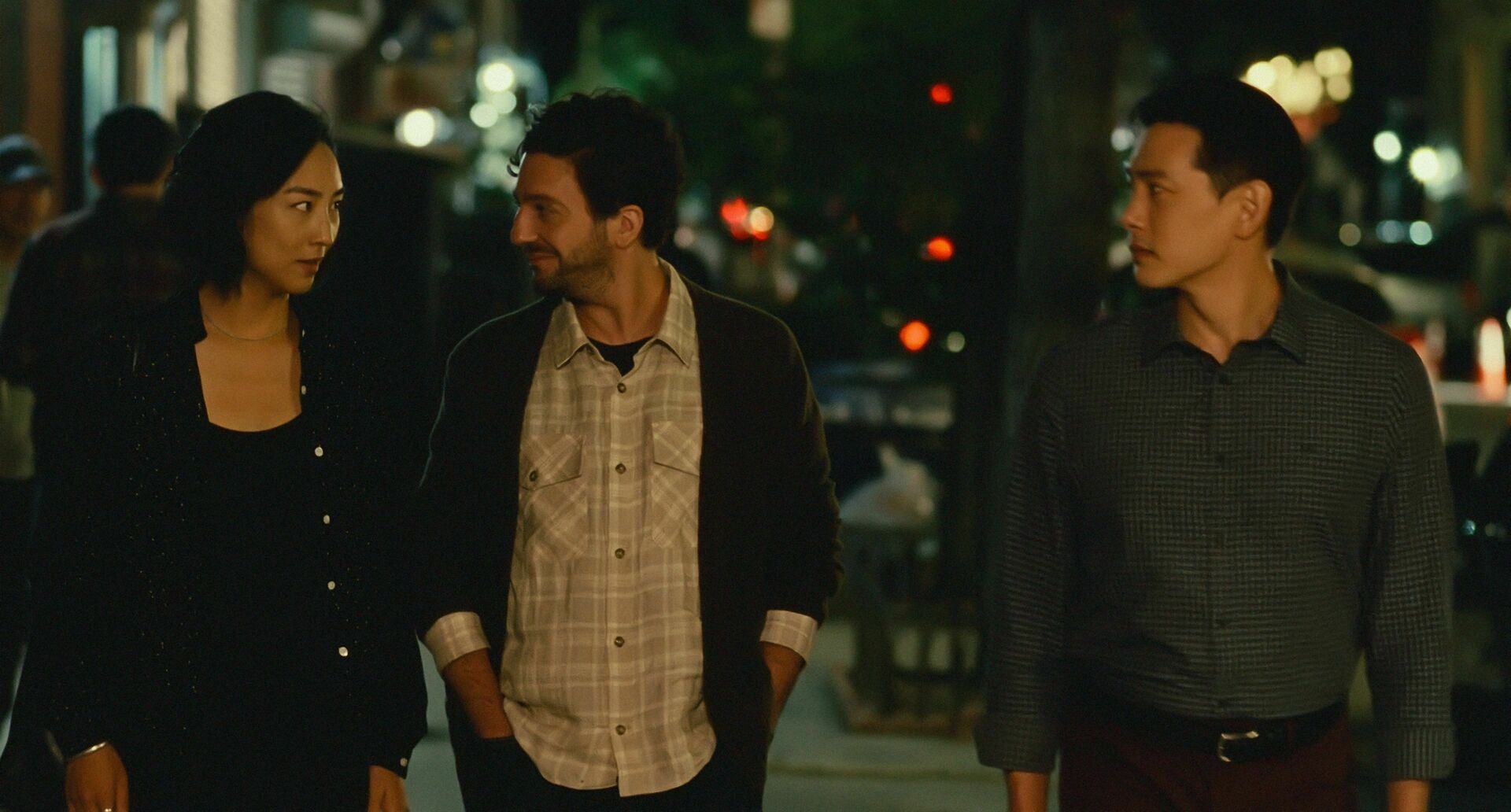
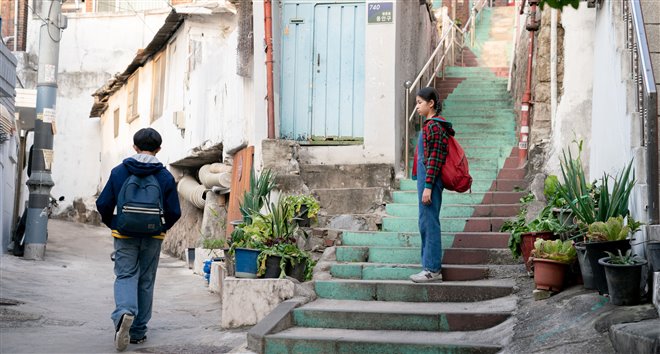
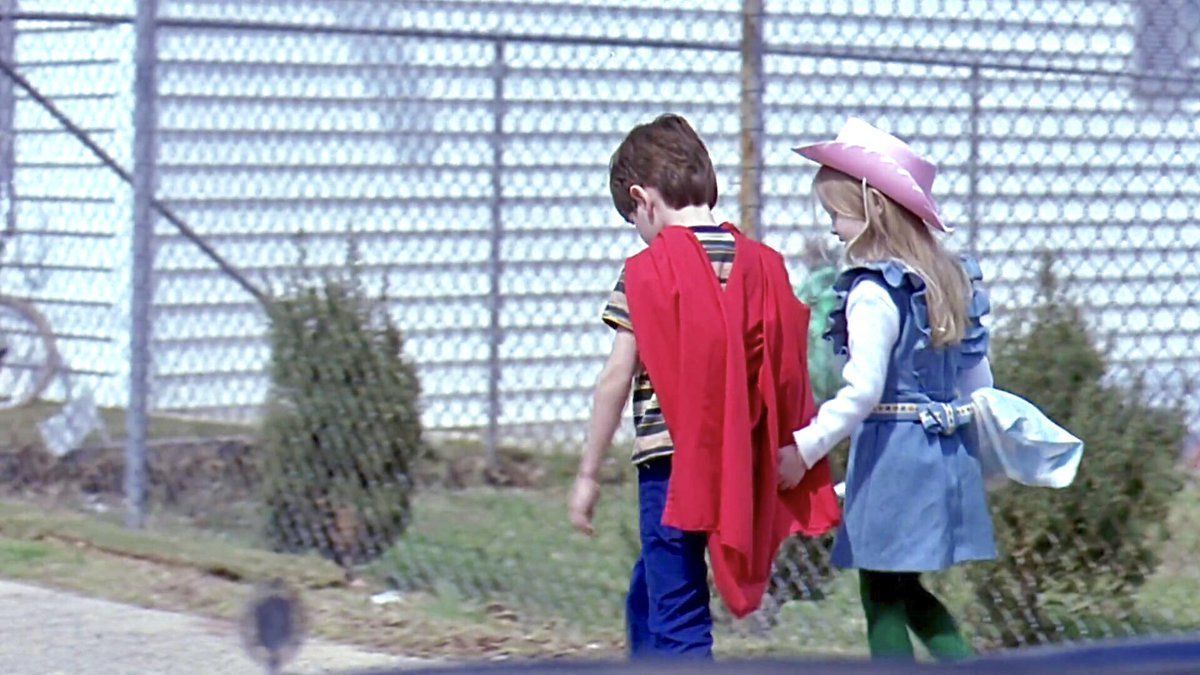
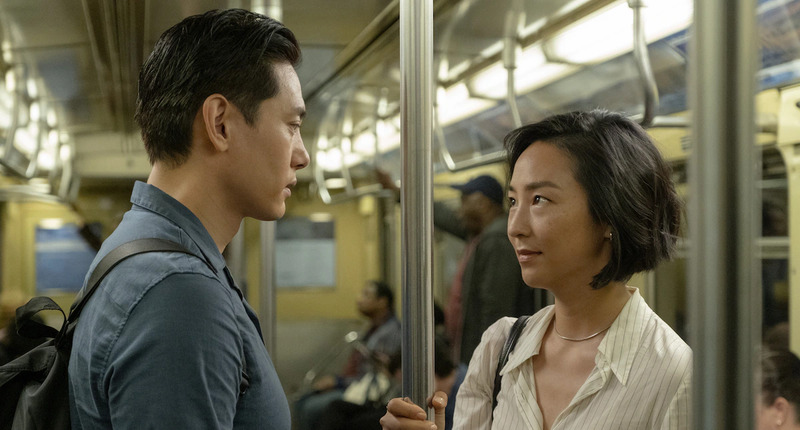
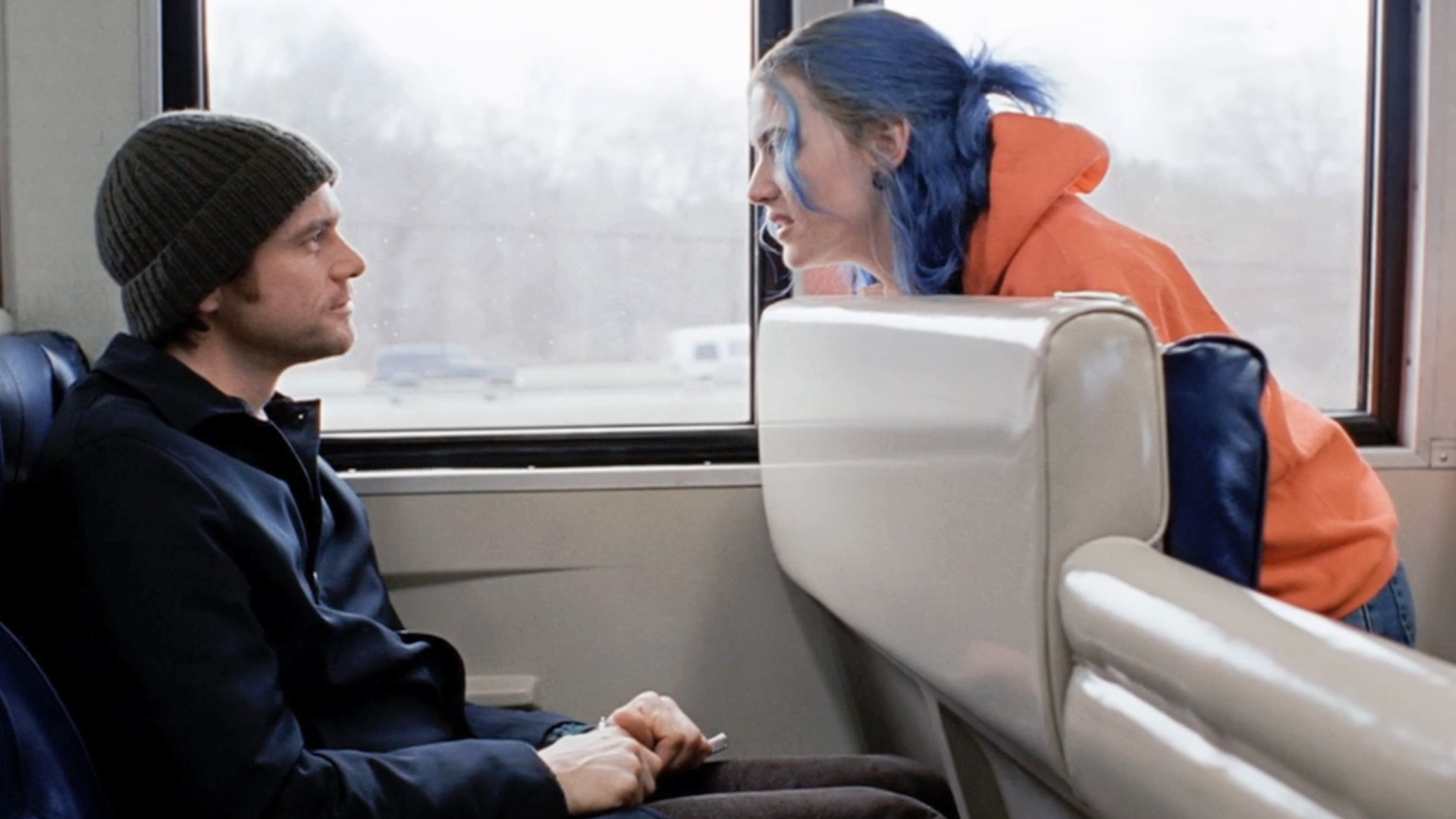
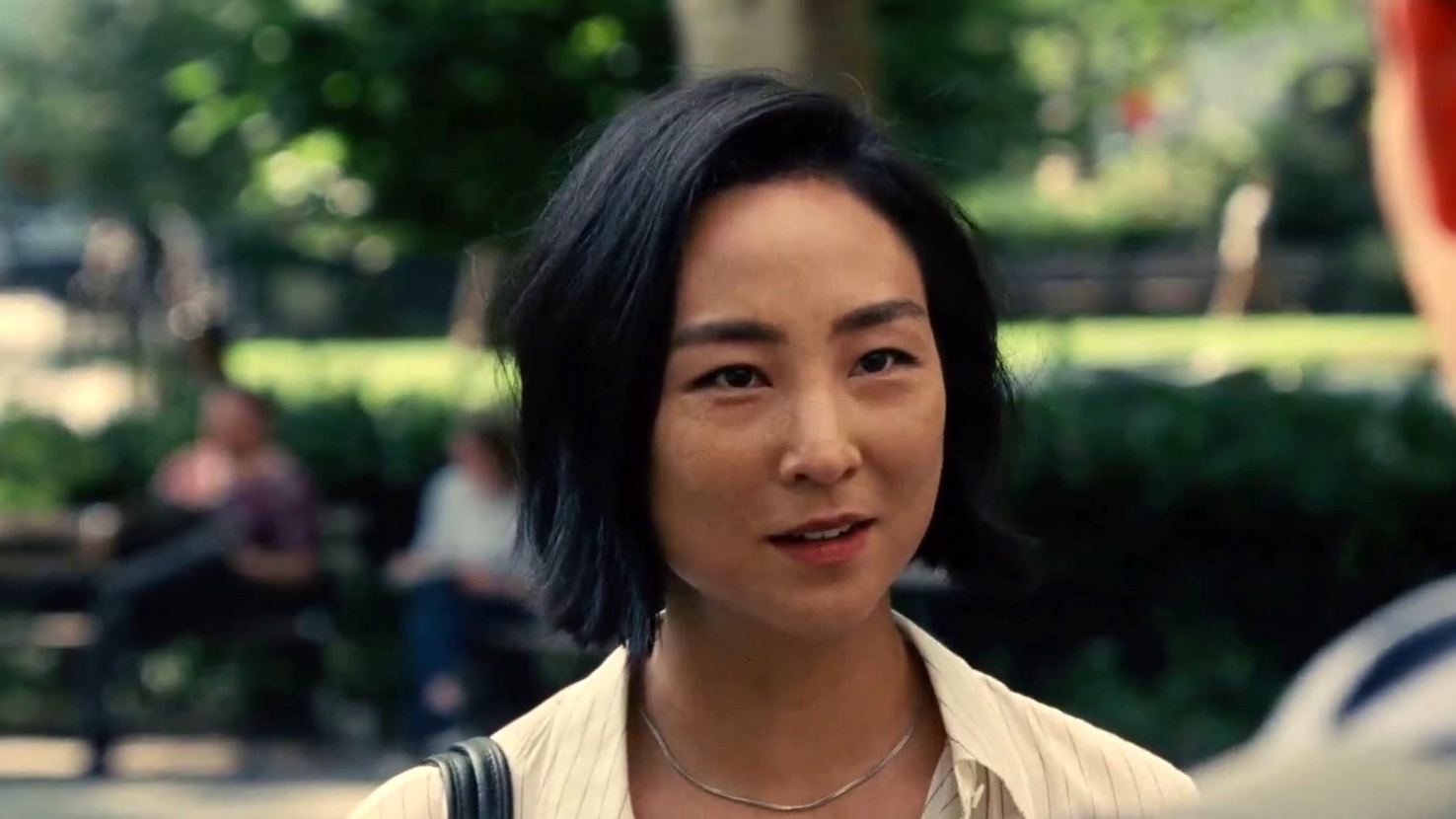
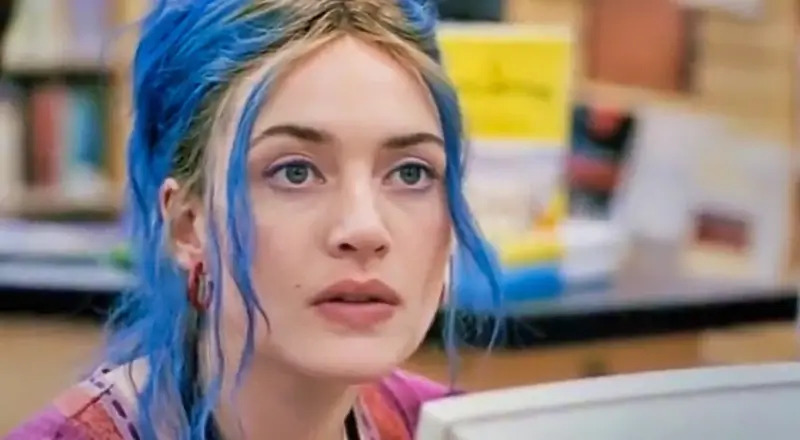

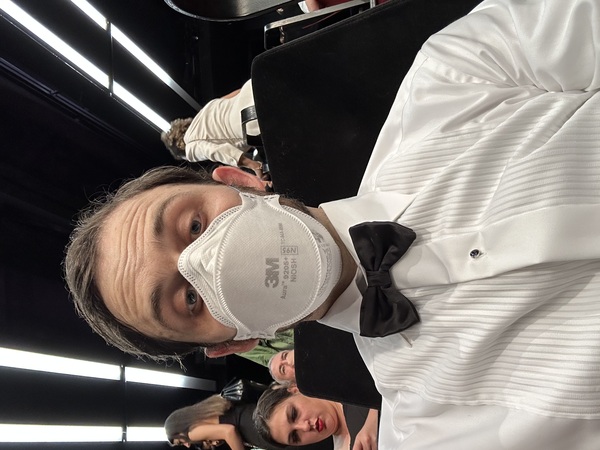
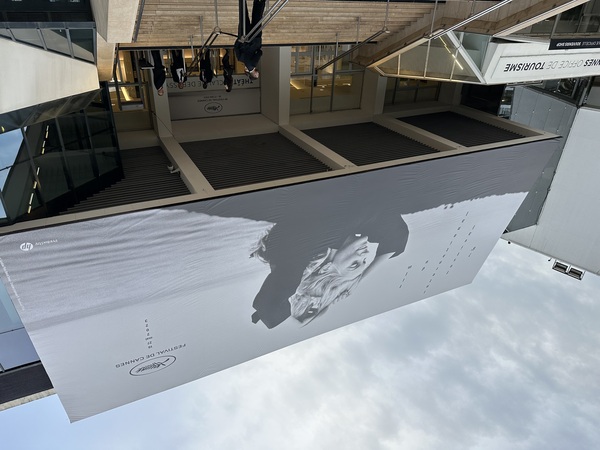
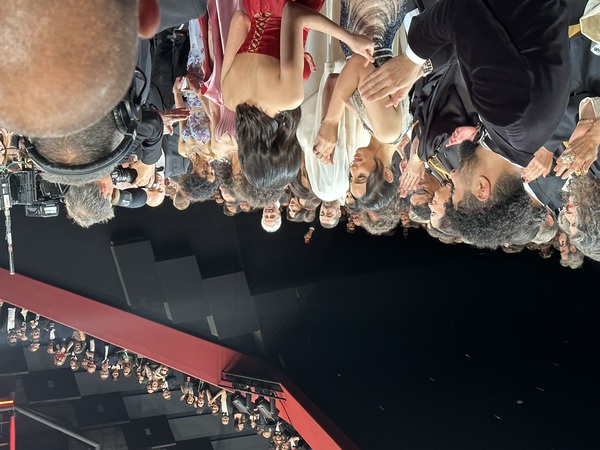
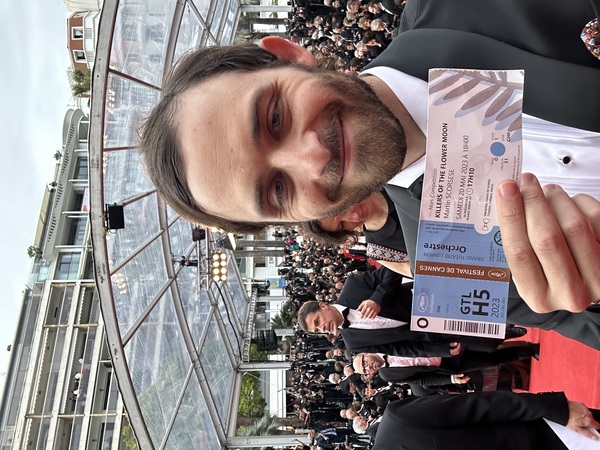

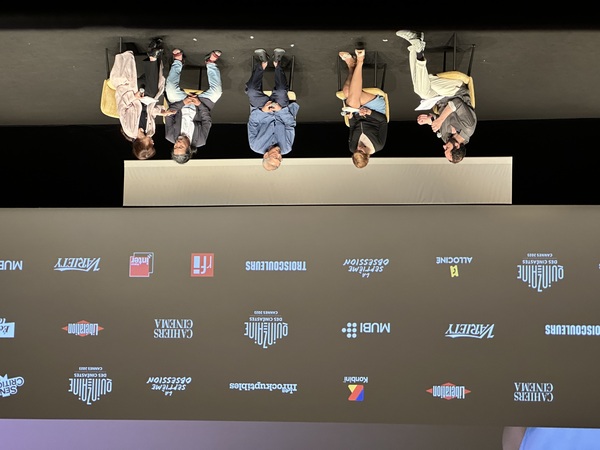
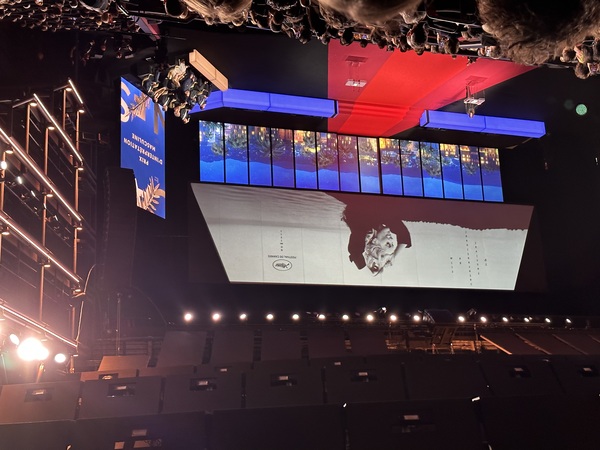

 What could I possibly say about Top Gun: Maverick that hasn’t been said a thousand times? I genuinely don’t know, and I don’t think it matters. If Maverick proves anything, it’s that novelty is overrated. Sometimes you just want the band to play the hits. Sometimes you want to forget about plot, character growth, and troubling geopolitical implications and just ride a roller coaster. Of course it’s running on a pre-ordained track; of course the loops won’t hurt you. But if you throw up your hands and surrender to physics, you’ll feel the adrenaline of actual danger. Tom Cruise pulling off a simulated mission will feel exactly as death-defying as the one with real stakes—it’s all the same forces with the same cheering crowd, it’s all just a matter of perspective. This is the sort of thrill ride you feel in your bones.
What could I possibly say about Top Gun: Maverick that hasn’t been said a thousand times? I genuinely don’t know, and I don’t think it matters. If Maverick proves anything, it’s that novelty is overrated. Sometimes you just want the band to play the hits. Sometimes you want to forget about plot, character growth, and troubling geopolitical implications and just ride a roller coaster. Of course it’s running on a pre-ordained track; of course the loops won’t hurt you. But if you throw up your hands and surrender to physics, you’ll feel the adrenaline of actual danger. Tom Cruise pulling off a simulated mission will feel exactly as death-defying as the one with real stakes—it’s all the same forces with the same cheering crowd, it’s all just a matter of perspective. This is the sort of thrill ride you feel in your bones. Jackass Forever is another movie you feel in your bones, and the primary feeling is pain. There’s a reason my wife didn’t join me in this screening; it’s the same reason I never in a million years thought I’d be putting it on a list. I am nothing like these people. I have never cared about their show. It physically hurts me to watch them! So why did I love it? The best answer I can give is “catharsis.” As we strangers gathered together in the theatre, crying out “OOOOOH” and “NOOOOO”s with the blunt repetition of a pogo stick, all that pain started to feel needed, somehow. A sharp release after two years of dull ache. Hilarious in the way the best nonsense is hilarious: hilarious that we were laughing, hilarious that at 11am on a Saturday in the midst of a still-raging pandemic we’d crawled out of our caves and put on shoes and pants to watch middle-aged men bruise for our amusement. It doesn’t make a lick of sense. It’s also the closest I’ve felt to a stranger in years.
Jackass Forever is another movie you feel in your bones, and the primary feeling is pain. There’s a reason my wife didn’t join me in this screening; it’s the same reason I never in a million years thought I’d be putting it on a list. I am nothing like these people. I have never cared about their show. It physically hurts me to watch them! So why did I love it? The best answer I can give is “catharsis.” As we strangers gathered together in the theatre, crying out “OOOOOH” and “NOOOOO”s with the blunt repetition of a pogo stick, all that pain started to feel needed, somehow. A sharp release after two years of dull ache. Hilarious in the way the best nonsense is hilarious: hilarious that we were laughing, hilarious that at 11am on a Saturday in the midst of a still-raging pandemic we’d crawled out of our caves and put on shoes and pants to watch middle-aged men bruise for our amusement. It doesn’t make a lick of sense. It’s also the closest I’ve felt to a stranger in years. In Emergency, Kunle is striving for respectability, unobtrusiveness. A Nigerian American with Ivy ambitions, he doesn’t rock the boat in his white-dominated university; he keeps his head down and plays by the rules. Whereas his best friend, Sean, is convinced the only move is not to play: Nothing he does will change society’s perception of him as a young Black man in this country. At the start of the film they’re a classic odd couple. Kunle wants to study but Sean wants to drink. Kunle avoids confrontations in class, Sean actively courts them to squeamish effect. But when they come home to find an underage white girl unconscious in their living room, their competing theories of the world are rendered consequential, concrete. If Kunle is right, the social contract demands they contact the police. If Sean is right, that impulse could prove impossibly naive—and dangerous. Are they protagonists in a hijinks-filled raunch-com, or the soon-to-be-victims of a harrowing drama? Eventually, someone needs to choose.
In Emergency, Kunle is striving for respectability, unobtrusiveness. A Nigerian American with Ivy ambitions, he doesn’t rock the boat in his white-dominated university; he keeps his head down and plays by the rules. Whereas his best friend, Sean, is convinced the only move is not to play: Nothing he does will change society’s perception of him as a young Black man in this country. At the start of the film they’re a classic odd couple. Kunle wants to study but Sean wants to drink. Kunle avoids confrontations in class, Sean actively courts them to squeamish effect. But when they come home to find an underage white girl unconscious in their living room, their competing theories of the world are rendered consequential, concrete. If Kunle is right, the social contract demands they contact the police. If Sean is right, that impulse could prove impossibly naive—and dangerous. Are they protagonists in a hijinks-filled raunch-com, or the soon-to-be-victims of a harrowing drama? Eventually, someone needs to choose. The fault lines in Athena couldn’t be more apparent: There’s a physical barricade and two armed, opposing sides. A riot has broken out in the Parisian banlieue, following the murder of a 13-year-old Algerian boy at the (documented) hands of the police. On one side are the rioters, wielding bricks and Molotov cocktails, demanding that justice be served. On the other are the French police, decked head to toe in riot gear, insisting that order be maintained. In the film’s visual vocabulary, this is a war zone. Straddling both armies is Abdel, himself a resident of Athena, a literal soldier and the older brother of the deceased. He’s calling for peace and justice simultaneously. He wants to deescalate the tension, to translate each side to the other, to reason his way to an armistice. But there’s no way to diffuse a lit bomb while preserving its potency: You either neutralize its agency or you support its right to burst. Brimming with anger and raw kinetic energy, Athena is a sprint towards a reckoning.
The fault lines in Athena couldn’t be more apparent: There’s a physical barricade and two armed, opposing sides. A riot has broken out in the Parisian banlieue, following the murder of a 13-year-old Algerian boy at the (documented) hands of the police. On one side are the rioters, wielding bricks and Molotov cocktails, demanding that justice be served. On the other are the French police, decked head to toe in riot gear, insisting that order be maintained. In the film’s visual vocabulary, this is a war zone. Straddling both armies is Abdel, himself a resident of Athena, a literal soldier and the older brother of the deceased. He’s calling for peace and justice simultaneously. He wants to deescalate the tension, to translate each side to the other, to reason his way to an armistice. But there’s no way to diffuse a lit bomb while preserving its potency: You either neutralize its agency or you support its right to burst. Brimming with anger and raw kinetic energy, Athena is a sprint towards a reckoning. Julie wants to understand her mother, Rosalind. It’s at once an act of love and a creative pursuit: Having already mined her own life as inspiration for her films
Julie wants to understand her mother, Rosalind. It’s at once an act of love and a creative pursuit: Having already mined her own life as inspiration for her films Rama doesn’t know Laurence Coly. If her testimony in Saint Omer is to be believed, few people have even noticed Coly since she immigrated from Senegal, let alone known her. But like Julie to her mother, Rama is driven by a creative impulse to try. Hers is less an attempt to connect than it is to solve a terrible puzzle. What would possess this thoughtful speaker, motivated student, and by all accounts loving mother to drown her infant daughter? Played with perfect restraint by Guslagie Malanda, Coly denies the charge of infanticide yet disputes few, if any, details. She walks through her life story patiently, methodically, not wholly devoid of emotion but miscalibrated somehow. It’s as if after years of feeling unseen, she’s forgotten how to reveal herself at all. Was it an act of desperation? Was she in any way coerced? Surely Rama—French-Senegalese herself, a novelist of tragedies, and four months pregnant at the time of this case—can find a “why” that reconciles the mother with her inconceivable actions. Without it, how can she quarantine the horror from her own life? How can any of us?
Rama doesn’t know Laurence Coly. If her testimony in Saint Omer is to be believed, few people have even noticed Coly since she immigrated from Senegal, let alone known her. But like Julie to her mother, Rama is driven by a creative impulse to try. Hers is less an attempt to connect than it is to solve a terrible puzzle. What would possess this thoughtful speaker, motivated student, and by all accounts loving mother to drown her infant daughter? Played with perfect restraint by Guslagie Malanda, Coly denies the charge of infanticide yet disputes few, if any, details. She walks through her life story patiently, methodically, not wholly devoid of emotion but miscalibrated somehow. It’s as if after years of feeling unseen, she’s forgotten how to reveal herself at all. Was it an act of desperation? Was she in any way coerced? Surely Rama—French-Senegalese herself, a novelist of tragedies, and four months pregnant at the time of this case—can find a “why” that reconciles the mother with her inconceivable actions. Without it, how can she quarantine the horror from her own life? How can any of us? Nan Goldin, the subject of All the Beauty and the Bloodshed, has devoted her life to telling stories. Some of those stories are painful; some are provocative; some are glamorizing; some are a disquieting combination of all three. Her goal isn’t to moralize or synthesize, it’s simply to highlight. And for the first hour or so of the film, I have to say I was caught off guard by the approach. Here was a documentary ostensibly about modern day activism and the opioid epidemic, which was spending the bulk of its time depicting the New York club scene of the 70’s and 80’s—reminiscing about an era which seemed at best unrelated to the current crisis, at worst stylistically complicit. Like one of Goldin’s slideshows, the film contextualizes by way of overwhelming. It asks us to sit with the unease until, eventually, connections start to form: between addiction and feeling discarded, between one epidemic and another. What emerges is less a message than an argument by example: You cannot fight what you don’t understand, and you cannot protect by way of euphemism. The messy, unpleasant, often brutal realities of life are our most potent weapons against a power that thrives on contentment. Look at it, before you try to solve it. Look at it, and make it impossible for them to look away.
Nan Goldin, the subject of All the Beauty and the Bloodshed, has devoted her life to telling stories. Some of those stories are painful; some are provocative; some are glamorizing; some are a disquieting combination of all three. Her goal isn’t to moralize or synthesize, it’s simply to highlight. And for the first hour or so of the film, I have to say I was caught off guard by the approach. Here was a documentary ostensibly about modern day activism and the opioid epidemic, which was spending the bulk of its time depicting the New York club scene of the 70’s and 80’s—reminiscing about an era which seemed at best unrelated to the current crisis, at worst stylistically complicit. Like one of Goldin’s slideshows, the film contextualizes by way of overwhelming. It asks us to sit with the unease until, eventually, connections start to form: between addiction and feeling discarded, between one epidemic and another. What emerges is less a message than an argument by example: You cannot fight what you don’t understand, and you cannot protect by way of euphemism. The messy, unpleasant, often brutal realities of life are our most potent weapons against a power that thrives on contentment. Look at it, before you try to solve it. Look at it, and make it impossible for them to look away. The fact that Holy Spider exists at all feels like an act of political protest. A Persian-language procedural which unfolds like a depraved Fincher saga, it puts moral rot on full display and dares us to blink. The most brazen examples come from Saeed, a serial killer who preys on sex workers in the holy city of Mashhad. We open on one of his soon-to-be victims, and we follow until she is no longer living. Nothing, and I mean nothing, is left to the imagination. Saeed’s horrific crimes are being investigated by Arezoo
The fact that Holy Spider exists at all feels like an act of political protest. A Persian-language procedural which unfolds like a depraved Fincher saga, it puts moral rot on full display and dares us to blink. The most brazen examples come from Saeed, a serial killer who preys on sex workers in the holy city of Mashhad. We open on one of his soon-to-be victims, and we follow until she is no longer living. Nothing, and I mean nothing, is left to the imagination. Saeed’s horrific crimes are being investigated by Arezoo Katia and Maurice Krafft love volcanoes. And I can think of no greater compliment than to say that watching Fire of Love made me love them too. Though the documentary includes multiple interviews with the volcanologist couple, its power doesn’t lie in their—or any—words. Rather, it lies in what they saw and preserved. Namely: gorgeous, terrifying, mesmeric footage of volcanoes in the act of erupting. Tiny silhouettes in heat-resistant silver, dwarfed against a skyscraper of magma. Smoke billowing like the fury of some vengeful Greek god. A color palette which has always existed—which is intricately tied with the creation of our world—yet somehow feels futuristic, alien whenever it’s on screen. It’s breathtaking, and at least to this viewer, an entirely novel sensation. By relentlessly pursuing their unorthodox obsessions, the Kraffts accomplished what so many artists aim to do. They made us see the world through their eyes, and see it as glorious.
Katia and Maurice Krafft love volcanoes. And I can think of no greater compliment than to say that watching Fire of Love made me love them too. Though the documentary includes multiple interviews with the volcanologist couple, its power doesn’t lie in their—or any—words. Rather, it lies in what they saw and preserved. Namely: gorgeous, terrifying, mesmeric footage of volcanoes in the act of erupting. Tiny silhouettes in heat-resistant silver, dwarfed against a skyscraper of magma. Smoke billowing like the fury of some vengeful Greek god. A color palette which has always existed—which is intricately tied with the creation of our world—yet somehow feels futuristic, alien whenever it’s on screen. It’s breathtaking, and at least to this viewer, an entirely novel sensation. By relentlessly pursuing their unorthodox obsessions, the Kraffts accomplished what so many artists aim to do. They made us see the world through their eyes, and see it as glorious. In After Yang, the process is even more direct: We literally see the world through Yang’s eyes. When the titular robot becomes unresponsive, his (human) family is left in a state of muted grief. They can talk about solutions (to fix or to replace?) but their sorrow seems to linger on the tip of their tongue. By and large, the film follows their emotional lead: delicate, tentative, lush but only to a point, hovering just on the periphery of heartbreak. All of that changes when, for reasons I won’t spoil, we’re granted access to Yang’s memories. Or rather to his attention—a few seconds per day which Yang deemed worthy of preserving. As we cycle through disconnected fragments of memory, every previously-muted emotion hits with full force. It’s a moving experience, and its meaning has continued to gnaw at me after multiple viewings. Beyond language and rationalization, the most profound mark we leave behind might be the world as we remix it, the particular parts we choose to edit down. Whether a bubbling pool of magma or the perfect cup of tea, we construct the found art of our lives. We forage for beauty and compare notes.
In After Yang, the process is even more direct: We literally see the world through Yang’s eyes. When the titular robot becomes unresponsive, his (human) family is left in a state of muted grief. They can talk about solutions (to fix or to replace?) but their sorrow seems to linger on the tip of their tongue. By and large, the film follows their emotional lead: delicate, tentative, lush but only to a point, hovering just on the periphery of heartbreak. All of that changes when, for reasons I won’t spoil, we’re granted access to Yang’s memories. Or rather to his attention—a few seconds per day which Yang deemed worthy of preserving. As we cycle through disconnected fragments of memory, every previously-muted emotion hits with full force. It’s a moving experience, and its meaning has continued to gnaw at me after multiple viewings. Beyond language and rationalization, the most profound mark we leave behind might be the world as we remix it, the particular parts we choose to edit down. Whether a bubbling pool of magma or the perfect cup of tea, we construct the found art of our lives. We forage for beauty and compare notes. In my
In my  If RRR is a comic book retelling of known revolutionary history, The Woman King is a reimagining of the revolutions that could have been. It’s also an act of historical revelation. The film centers around the Agojie, an all-woman warrior unit who served the 19th century Kingdom of Dahomey in what is now (primarily) Benin. If this is your first time learning that an entirely woman-led fighting force not only existed, but existed for centuries, you aren’t alone: Beyond the bloody action sequences, the film’s most thrilling aspect might be that sense of discovery, excavation. Having established their well-recorded prowess in battle, the film turns its attention to possible points of inflection. What if the Agojie had been allowed to lead, rather than merely serve the King? What if the Kingdom wielded the brunt of its power against the encroaching Portuguese, against the slave trade itself? There are real stories, here, stochastic acts of revolution and revolt that are accumulated into one potent charge. Some view that as revisionistic; I view it as a battle cry. This is what the world could be. It only takes a spark.
If RRR is a comic book retelling of known revolutionary history, The Woman King is a reimagining of the revolutions that could have been. It’s also an act of historical revelation. The film centers around the Agojie, an all-woman warrior unit who served the 19th century Kingdom of Dahomey in what is now (primarily) Benin. If this is your first time learning that an entirely woman-led fighting force not only existed, but existed for centuries, you aren’t alone: Beyond the bloody action sequences, the film’s most thrilling aspect might be that sense of discovery, excavation. Having established their well-recorded prowess in battle, the film turns its attention to possible points of inflection. What if the Agojie had been allowed to lead, rather than merely serve the King? What if the Kingdom wielded the brunt of its power against the encroaching Portuguese, against the slave trade itself? There are real stories, here, stochastic acts of revolution and revolt that are accumulated into one potent charge. Some view that as revisionistic; I view it as a battle cry. This is what the world could be. It only takes a spark. Given the title, you might assume the comfort The Menu is skewering is food. And it is, in a sense—a horror film set at a world-renowned restaurant whose progressive tasting menu grows more violent by the course, it has plenty to say about elitism and dining. But the deepest targets of its ire have nothing to do with eating and everything to do with performance. It’s the Instagram story of the perfectly plated meal, the hallowed Authentic Experience™ fetishized to a commodity. Paying a premium for the bragging right of eating food you likely hate; exclusive membership to a club, password “mouthfeel.” It’s about the way wealth and the pursuit of status hollow you out, strip everything of enjoyment including the act of enjoying something. Like the best satirical comedies, The Menu knows how to execute on precisely what it’s criticizing. It knows how to be highbrow, how to sprinkle in a grace note or witheringly specific dig
Given the title, you might assume the comfort The Menu is skewering is food. And it is, in a sense—a horror film set at a world-renowned restaurant whose progressive tasting menu grows more violent by the course, it has plenty to say about elitism and dining. But the deepest targets of its ire have nothing to do with eating and everything to do with performance. It’s the Instagram story of the perfectly plated meal, the hallowed Authentic Experience™ fetishized to a commodity. Paying a premium for the bragging right of eating food you likely hate; exclusive membership to a club, password “mouthfeel.” It’s about the way wealth and the pursuit of status hollow you out, strip everything of enjoyment including the act of enjoying something. Like the best satirical comedies, The Menu knows how to execute on precisely what it’s criticizing. It knows how to be highbrow, how to sprinkle in a grace note or witheringly specific dig White Noise is based on a major work of postmodern literature; there’s a chance it was assigned to you in college. Yet, perhaps more than any entry on this list, it reads like a critique of our particular decade. Culture has become fragmented and hyper-specific. A rising interest in the
White Noise is based on a major work of postmodern literature; there’s a chance it was assigned to you in college. Yet, perhaps more than any entry on this list, it reads like a critique of our particular decade. Culture has become fragmented and hyper-specific. A rising interest in the  It’s tempting to read Bones and All purely as an allegory. Certainly, it has the raw materials. The queer-coded coming-of-age drama follows young cannibals living in Reagan-era America, whose desires thrust them to the fringes of society. Marked as definitionally “dangerous,” they’re left with no choice but to forge new ways of being. All the beauty, all the bloodshed. What I adore about this film, though, is its refusal to map neatly onto one didactic point. Drown out the social context and consider Maren and Lee on their own terms. They have this passion, this intensity of want they can’t control. It doesn’t just seem dangerous because it violates the social order; it is (in defiance of metaphor) a genuinely violent compulsion, a need to draw blood. They’ve hurt people in the past, and they’re likely to hurt again. Rather than ask us to fully fear them or forgive them, the film simply asks us to feel them. The dull ache of desire and the threat of its fulfillment. The self-loathing that comes after; if only you were stronger. How painful it must be to be at war with yourself. How freeing to lie back in the passenger seat, to peel off the armor, to share in the whole bloody mess. The text of the film is part horror, part tragedy, but the texture is pure romance. It’s love and sex and yearning and danger and self-hatred and -actualization, melded into one intractable feeling. It says “Take me, all of me, exactly as I am.”
It’s tempting to read Bones and All purely as an allegory. Certainly, it has the raw materials. The queer-coded coming-of-age drama follows young cannibals living in Reagan-era America, whose desires thrust them to the fringes of society. Marked as definitionally “dangerous,” they’re left with no choice but to forge new ways of being. All the beauty, all the bloodshed. What I adore about this film, though, is its refusal to map neatly onto one didactic point. Drown out the social context and consider Maren and Lee on their own terms. They have this passion, this intensity of want they can’t control. It doesn’t just seem dangerous because it violates the social order; it is (in defiance of metaphor) a genuinely violent compulsion, a need to draw blood. They’ve hurt people in the past, and they’re likely to hurt again. Rather than ask us to fully fear them or forgive them, the film simply asks us to feel them. The dull ache of desire and the threat of its fulfillment. The self-loathing that comes after; if only you were stronger. How painful it must be to be at war with yourself. How freeing to lie back in the passenger seat, to peel off the armor, to share in the whole bloody mess. The text of the film is part horror, part tragedy, but the texture is pure romance. It’s love and sex and yearning and danger and self-hatred and -actualization, melded into one intractable feeling. It says “Take me, all of me, exactly as I am.” If Maren and Lee find belonging in the open road, Casey is searching for it in an endless, scrolling feed. By the time we meet the protagonist of We’re All Going to the World’s Fair, she’s already formed a truce with her demons. She knows that she’s hurting and she doesn’t expect it to stop. What she wants is to make it be important. To find some audience to connect her pain to something bigger, who can rescue her from the oppressiveness of her isolated teenage life. What they witness is unsettling; I won’t spoil it here. But beyond this film’s horror trappings lies what might be the most perceptive look at modern adolescence since
If Maren and Lee find belonging in the open road, Casey is searching for it in an endless, scrolling feed. By the time we meet the protagonist of We’re All Going to the World’s Fair, she’s already formed a truce with her demons. She knows that she’s hurting and she doesn’t expect it to stop. What she wants is to make it be important. To find some audience to connect her pain to something bigger, who can rescue her from the oppressiveness of her isolated teenage life. What they witness is unsettling; I won’t spoil it here. But beyond this film’s horror trappings lies what might be the most perceptive look at modern adolescence since  Lydia Tár is nobody’s victim. An accomplished conductor, composer, author, and public intellectual, she seems wholly in control of every facet of her life. After all, she fashioned it herself. TÁR is likewise a meticulous construction. In terms of pure craft, I consider it the most flawless entry on my list. The same, however, cannot be said for its namesake. In one early impromptu lecture, we’re given a glimpse of her contradictions. She’s engaging, dynamic, passionate, persuasive, and also patently, toxically wrong. Her arrogance is unwavering and all-consuming. It will take no small force to uproot it. But piece by piece, with virtuosic precision, the film guides us through the movements that will do so. It first asks us to see the world from her eyes, to be hypnotized by her self mythology. Thus calibrated, we—like Lydia—are primed to perceive whatever threatens her position as a mysterious (even supernatural) threat. What else can kill a god, can take down nobody’s victim? The result is slowly unfurling nightmare.
Lydia Tár is nobody’s victim. An accomplished conductor, composer, author, and public intellectual, she seems wholly in control of every facet of her life. After all, she fashioned it herself. TÁR is likewise a meticulous construction. In terms of pure craft, I consider it the most flawless entry on my list. The same, however, cannot be said for its namesake. In one early impromptu lecture, we’re given a glimpse of her contradictions. She’s engaging, dynamic, passionate, persuasive, and also patently, toxically wrong. Her arrogance is unwavering and all-consuming. It will take no small force to uproot it. But piece by piece, with virtuosic precision, the film guides us through the movements that will do so. It first asks us to see the world from her eyes, to be hypnotized by her self mythology. Thus calibrated, we—like Lydia—are primed to perceive whatever threatens her position as a mysterious (even supernatural) threat. What else can kill a god, can take down nobody’s victim? The result is slowly unfurling nightmare. The nightmare in Resurrection is decidedly more literal. Margaret’s tormentor is no hazy manifestation of some inevitable future reckoning. He’s a flesh-and-blood man sitting on a park bench in broad daylight, sharpened canines puncturing a cruel and feral smile. Outwardly, Margaret exists as the epitome of confidence: the high-powered executive who plays her boardroom like a fiddle; the single mother who champions self-sufficiency to a fault. But now he’s clawed his way back from the past to the park bench, and brought with him a host of anxieties. If this sounds like the plot of a demented horror flick—and, spoilers, it absolutely is—it’s also a riveting drama. Over the course of a monologue of Bergman proportions, we watch Margaret peel back every carefully-constructed layer. Her unraveling is too massive to be pigeonholed by genre: She, and the film, defy everything. It’s unnerving to witness someone tear so much away. I have no clue what to make of it; it still lives inside me.
The nightmare in Resurrection is decidedly more literal. Margaret’s tormentor is no hazy manifestation of some inevitable future reckoning. He’s a flesh-and-blood man sitting on a park bench in broad daylight, sharpened canines puncturing a cruel and feral smile. Outwardly, Margaret exists as the epitome of confidence: the high-powered executive who plays her boardroom like a fiddle; the single mother who champions self-sufficiency to a fault. But now he’s clawed his way back from the past to the park bench, and brought with him a host of anxieties. If this sounds like the plot of a demented horror flick—and, spoilers, it absolutely is—it’s also a riveting drama. Over the course of a monologue of Bergman proportions, we watch Margaret peel back every carefully-constructed layer. Her unraveling is too massive to be pigeonholed by genre: She, and the film, defy everything. It’s unnerving to witness someone tear so much away. I have no clue what to make of it; it still lives inside me. Everyone on Inisherin seems to have a different answer. Pádraic is at peace with the smallness of his life and sees contentment as the ultimate aim. The people he loves are his legacy. His sister Siobhán wants to expand her horizons: She hasn’t seen enough of the world to know whom to live for. Then there’s Colm, whose existential crisis serves as The Banshees of Inisherin’s narrative fulcrum. Colm is fine with smallness, with a narrow field of influence. He has no desire to leave the confines of his home. What he can’t stand is that which Pádraic most values: impermanence. Evening pints with buddies, hours in the company of animals, unsung opportunities for kindness. They’re special precisely because they’re intimate, fleeting. But music—music is eternal. Dwarfed by the infinite, Colm’s day-to-day relationships seem like petty distractions. He doesn’t want to be cruel, exactly, but what is the weight of kindness when stacked up against eternal pursuits? If all the kindness of a lifetime were hurled against a door, would it make a sound worth studying like Mozart? A pitch black comedy about the human condition, Banshees refuses to offer up a villain or an answer.
Everyone on Inisherin seems to have a different answer. Pádraic is at peace with the smallness of his life and sees contentment as the ultimate aim. The people he loves are his legacy. His sister Siobhán wants to expand her horizons: She hasn’t seen enough of the world to know whom to live for. Then there’s Colm, whose existential crisis serves as The Banshees of Inisherin’s narrative fulcrum. Colm is fine with smallness, with a narrow field of influence. He has no desire to leave the confines of his home. What he can’t stand is that which Pádraic most values: impermanence. Evening pints with buddies, hours in the company of animals, unsung opportunities for kindness. They’re special precisely because they’re intimate, fleeting. But music—music is eternal. Dwarfed by the infinite, Colm’s day-to-day relationships seem like petty distractions. He doesn’t want to be cruel, exactly, but what is the weight of kindness when stacked up against eternal pursuits? If all the kindness of a lifetime were hurled against a door, would it make a sound worth studying like Mozart? A pitch black comedy about the human condition, Banshees refuses to offer up a villain or an answer.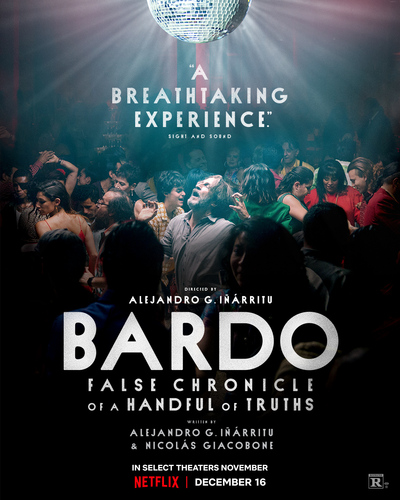 In BARDO, False Chronicle of a Handful of Truths, the argument isn’t divvied up between a roving cast of townspeople: Silverio embodies every side at once. The immediacy of family, the permanence of art, the security of a hometown, the tug of new horizons. To further his directorial ambitions, the thinly-veiled Iñáritu surrogate left Mexico City for Los Angeles early in his career. And on paper, the gambit paid off: He is critically acclaimed, his films are widely seen, and his family still lives under one roof. But now, as he prepares a speech for a ceremony held in his honor, he questions every decision. He moved to California to make his art more accessible, but by leaving the city that forged him, has he diluted his own perspective? Is it onanistic to strive for purity, or is it “selling out” to cater to your audience? And who is this audience anyway—pretentious snobs on one extreme, blood-hungry mob on the other. He still knows how to dazzle them, but to what end? Iñáritu still knows how to dazzle us too. Framing Silverio’s inner turmoil as a series of Fellini-esque flights of fancy, his self-critique is nothing if not wildly entertaining. Critics have called it indulgent, but I was bowled over by BARDO’s towering self-awareness
In BARDO, False Chronicle of a Handful of Truths, the argument isn’t divvied up between a roving cast of townspeople: Silverio embodies every side at once. The immediacy of family, the permanence of art, the security of a hometown, the tug of new horizons. To further his directorial ambitions, the thinly-veiled Iñáritu surrogate left Mexico City for Los Angeles early in his career. And on paper, the gambit paid off: He is critically acclaimed, his films are widely seen, and his family still lives under one roof. But now, as he prepares a speech for a ceremony held in his honor, he questions every decision. He moved to California to make his art more accessible, but by leaving the city that forged him, has he diluted his own perspective? Is it onanistic to strive for purity, or is it “selling out” to cater to your audience? And who is this audience anyway—pretentious snobs on one extreme, blood-hungry mob on the other. He still knows how to dazzle them, but to what end? Iñáritu still knows how to dazzle us too. Framing Silverio’s inner turmoil as a series of Fellini-esque flights of fancy, his self-critique is nothing if not wildly entertaining. Critics have called it indulgent, but I was bowled over by BARDO’s towering self-awareness Immediately after leaving my screening of Aftersun, I knew it would land in my number one slot
Immediately after leaving my screening of Aftersun, I knew it would land in my number one slot If Aftersun is my personal favorite of the year, Everything Everywhere All at Once is the film which best encapsulates the year. Watching this frenetic multiverse saga feels like living through 2022: overwhelming, oversaturated, tugged in too many directions to move. Evelyn feels it; so does Joy. That temptation to be rendered numb by the enormity of everything, to be swept up in the riptide of
If Aftersun is my personal favorite of the year, Everything Everywhere All at Once is the film which best encapsulates the year. Watching this frenetic multiverse saga feels like living through 2022: overwhelming, oversaturated, tugged in too many directions to move. Evelyn feels it; so does Joy. That temptation to be rendered numb by the enormity of everything, to be swept up in the riptide of 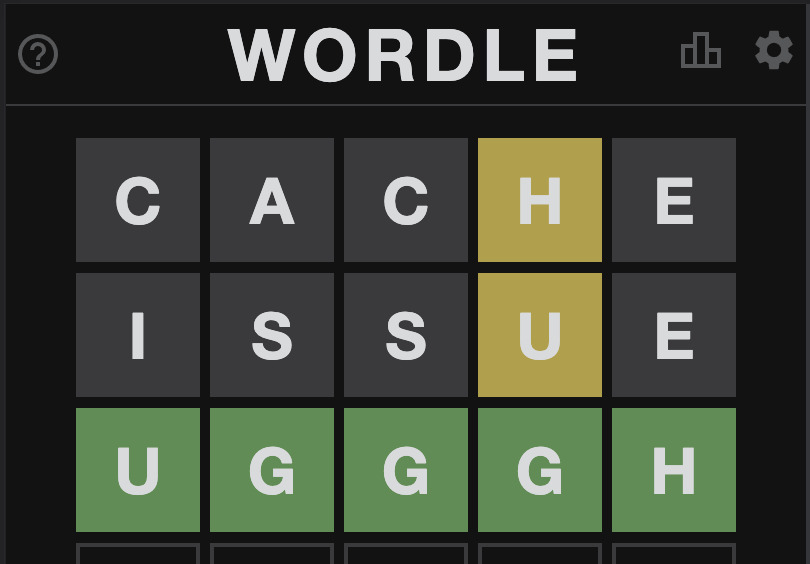
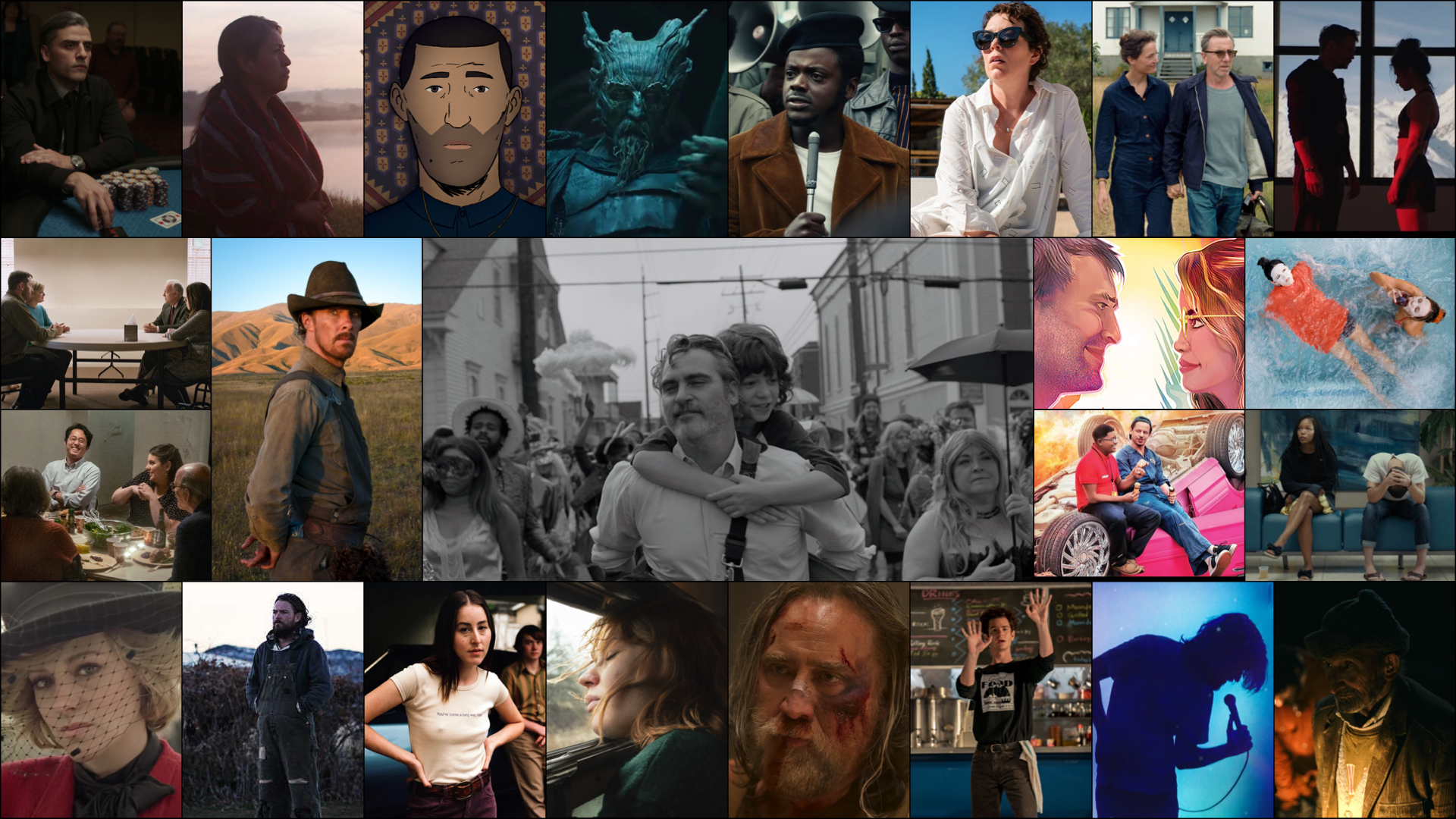
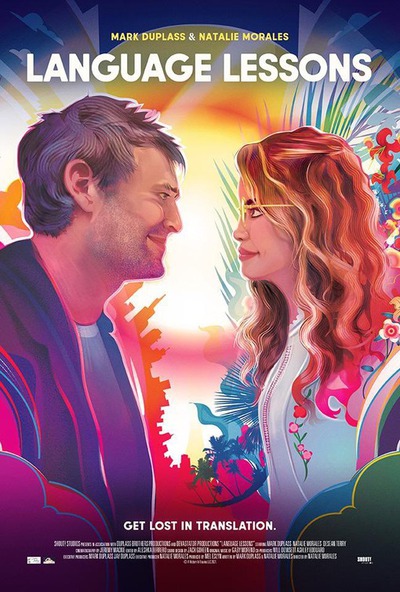 Friendship can flourish in the most unexpected places. In Language Lessons, that place is a video chat. Cariño is a Spanish language teacher based in Costa Rica; Adam lives in Oakland with his wealthy, doting husband, who has gifted him a hundred Spanish lessons. What follows is a charming, minimalist drama about human connection. Adam and Cariño’s relationship is defined by limitation: they have never met in person, know nothing of each other’s histories, and the former’s Spanish vocab is childlike at best. Far from being a hindrance, though, those limits only deepen their connection. Truth by way of brevity. There’s a soulful undercurrent to their early lessons together, the way they fumblingly reveal themselves despite their best intentions. We can feel something personal wriggling to break free, made all the more lovely by the struggle.
Friendship can flourish in the most unexpected places. In Language Lessons, that place is a video chat. Cariño is a Spanish language teacher based in Costa Rica; Adam lives in Oakland with his wealthy, doting husband, who has gifted him a hundred Spanish lessons. What follows is a charming, minimalist drama about human connection. Adam and Cariño’s relationship is defined by limitation: they have never met in person, know nothing of each other’s histories, and the former’s Spanish vocab is childlike at best. Far from being a hindrance, though, those limits only deepen their connection. Truth by way of brevity. There’s a soulful undercurrent to their early lessons together, the way they fumblingly reveal themselves despite their best intentions. We can feel something personal wriggling to break free, made all the more lovely by the struggle.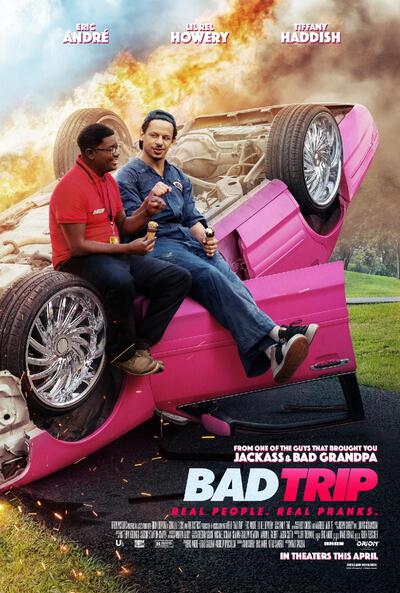 Bad Trip might strike some as an odd inclusion on this list. A hidden camera prank show wrapped in a zany road trip comedy, it’s about as far removed from “minimalist drama” as you can get. On multiple levels, though, this is an earnest ode to companionship and shared…well, let’s just say experiences. Strip away the hilariously R-rated set-pieces and nonsensical plot machinations, and you’re left with a surprisingly sweet saga about two best friends. But it’s the meta story that really pulled me in. There’s something genuinely communal about watching this: It made me feel present with the cast unlike anything else this year. With its anarchic swerving between reality and fiction, Bad Trip implicates the viewer in every manic escalation and dear-god-don’t-tell-me-they’re-gonna twist. It has the cadence of a joke you had to be there to find funny, and a heart that’s big and silly enough to bring us along for the ride.
Bad Trip might strike some as an odd inclusion on this list. A hidden camera prank show wrapped in a zany road trip comedy, it’s about as far removed from “minimalist drama” as you can get. On multiple levels, though, this is an earnest ode to companionship and shared…well, let’s just say experiences. Strip away the hilariously R-rated set-pieces and nonsensical plot machinations, and you’re left with a surprisingly sweet saga about two best friends. But it’s the meta story that really pulled me in. There’s something genuinely communal about watching this: It made me feel present with the cast unlike anything else this year. With its anarchic swerving between reality and fiction, Bad Trip implicates the viewer in every manic escalation and dear-god-don’t-tell-me-they’re-gonna twist. It has the cadence of a joke you had to be there to find funny, and a heart that’s big and silly enough to bring us along for the ride.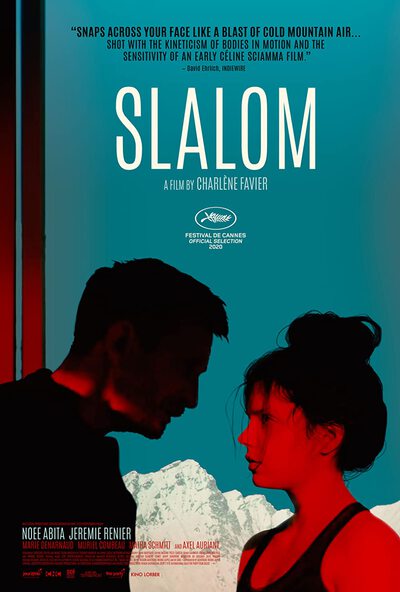 Slalom is centered on the perspective of Lyz, a 15-year-old athlete who spends her days training at a remote, Alpine ski academy. She’s independent, motivated, and—under the tutelage of her adult instructor Fred—seems to be on track for greatness.
That sort of internal striving can be its own overwhelming pressure, and Fred amplifies that pressure at every opportunity. But what seems at first blush to be a wintry spin on Whiplash
Slalom is centered on the perspective of Lyz, a 15-year-old athlete who spends her days training at a remote, Alpine ski academy. She’s independent, motivated, and—under the tutelage of her adult instructor Fred—seems to be on track for greatness.
That sort of internal striving can be its own overwhelming pressure, and Fred amplifies that pressure at every opportunity. But what seems at first blush to be a wintry spin on Whiplash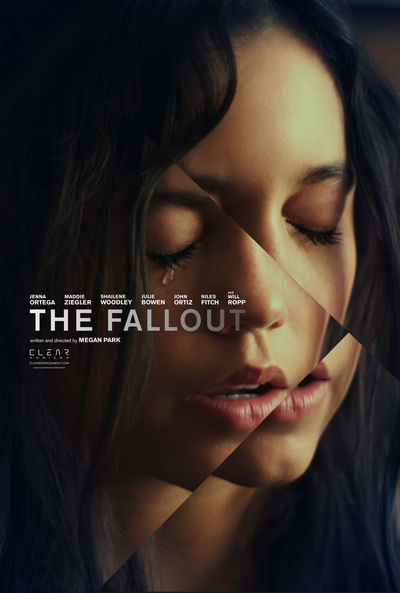 The Fallout takes a similarly naturalistic tact in its portrait of a different form of trauma. Vada is an eminently clever junior in high school, whose world is undone by a mass shooting at school. Or at least, her family presumes it’s been undone. After coming down from an initial state of shock, what’s most concerning is just how little she’s changed. She has the same deprecating humor, the same easygoing charm, same self-fulfilling insistence that everything is fine. Like Lyz, her instinctive coping strategy is a fake-it-till-you-make-it brand of strength: accept the situation and keep moving. But while her classmates are divided between putting tragedy in the rear-view and channeling their outrage into activism, Vada’s keep-moving intentions leave her firmly stuck in place. She can’t make forward motion until she’s acknowledged that she’s hurting, but to acknowledge it would shatter the only protective tool she has. What I adore about this film is Vada’s beating heart at its center: a cocktail of irony and sincerity, energy and stasis, which feels remarkably true to this moment. Through her struggle to modulate her outlook while retaining that vulnerable core, we see a glimmer of the adult she’s poised to become. If she’s any indication, we have reason to be hopeful.
The Fallout takes a similarly naturalistic tact in its portrait of a different form of trauma. Vada is an eminently clever junior in high school, whose world is undone by a mass shooting at school. Or at least, her family presumes it’s been undone. After coming down from an initial state of shock, what’s most concerning is just how little she’s changed. She has the same deprecating humor, the same easygoing charm, same self-fulfilling insistence that everything is fine. Like Lyz, her instinctive coping strategy is a fake-it-till-you-make-it brand of strength: accept the situation and keep moving. But while her classmates are divided between putting tragedy in the rear-view and channeling their outrage into activism, Vada’s keep-moving intentions leave her firmly stuck in place. She can’t make forward motion until she’s acknowledged that she’s hurting, but to acknowledge it would shatter the only protective tool she has. What I adore about this film is Vada’s beating heart at its center: a cocktail of irony and sincerity, energy and stasis, which feels remarkably true to this moment. Through her struggle to modulate her outlook while retaining that vulnerable core, we see a glimmer of the adult she’s poised to become. If she’s any indication, we have reason to be hopeful. In Spencer, Princess Diana is dealing with a host of pressures. There’s the overbearing family that police her every move, the vulture-like prowling of the British tabloid press, and the emotionally frigid husband who only makes both matters worse. Over a three-day Christmas visit to their royal estate, she is physically and emotionally trapped. Forced to dress lavishly but never provocatively, to eat indulgently as performance (despite her struggles with food), to pantomime “transparency” without showing a modicum of pain. Hers is a haunted house within a haunted house. She’s holed up in a mansion whose curtains are literally sewn shut, and she can’t escape the confines of her head—an inner voice (and outer Anne Boleyn) that insists her plight is preordained. When she finally does break free of both in service to a miracle, it’s a shared release of tension unlike any I’ve seen this year.
In Spencer, Princess Diana is dealing with a host of pressures. There’s the overbearing family that police her every move, the vulture-like prowling of the British tabloid press, and the emotionally frigid husband who only makes both matters worse. Over a three-day Christmas visit to their royal estate, she is physically and emotionally trapped. Forced to dress lavishly but never provocatively, to eat indulgently as performance (despite her struggles with food), to pantomime “transparency” without showing a modicum of pain. Hers is a haunted house within a haunted house. She’s holed up in a mansion whose curtains are literally sewn shut, and she can’t escape the confines of her head—an inner voice (and outer Anne Boleyn) that insists her plight is preordained. When she finally does break free of both in service to a miracle, it’s a shared release of tension unlike any I’ve seen this year. No paparazzi are spying on the family in The Humans. But as they celebrate Thanksgiving in their daughter’s Chinatown apartment, it’s hard not to feel that same whiff of performance. They are happy to be together; happy to meet the new boyfriend; happy to finally catch up on one another’s lives. When it comes time to communicate, though, everything is strained. Their conversations hit all the usual nerves: political fissures, jabs about finances, closed-minded quips that land with a thud. There are other nerves, too, unspoken relational wounds they seemingly can’t help but pick at. Here, the haunted house aspect is rendered surprisingly literal. Unplaceable noises, flickering lights, clumps of paint and water damage which appear metastatic, looming. The apartment functions both as a symbol of their discomfort and as an active, taunting participant: luring different pairs away from the group, lulling them into a false sense of security, betraying them with its lurches and paper-thin walls.
No paparazzi are spying on the family in The Humans. But as they celebrate Thanksgiving in their daughter’s Chinatown apartment, it’s hard not to feel that same whiff of performance. They are happy to be together; happy to meet the new boyfriend; happy to finally catch up on one another’s lives. When it comes time to communicate, though, everything is strained. Their conversations hit all the usual nerves: political fissures, jabs about finances, closed-minded quips that land with a thud. There are other nerves, too, unspoken relational wounds they seemingly can’t help but pick at. Here, the haunted house aspect is rendered surprisingly literal. Unplaceable noises, flickering lights, clumps of paint and water damage which appear metastatic, looming. The apartment functions both as a symbol of their discomfort and as an active, taunting participant: luring different pairs away from the group, lulling them into a false sense of security, betraying them with its lurches and paper-thin walls. When analyzing the year via the movies it produced, Bo Burnham: Inside almost feels like a cheat. A hybrid comedy special/performance art piece shot and set entirely in the pandemic, communicating “how it felt” is its overriding point. That it communicates it so deftly would, alone, merit inclusion on this list: Scroll through TikTok and find me any other work that so clearly struck a nerve. But what really sets the special apart for me is how well it speaks to the non-pandemic aspects. The character of Bo Burnham (and this is very much a character) lives in a world that is somehow post -irony and -sincerity. Overwhelmed by an amalgamation of contradictory inputs, the quickest way to express the truth is to present competing versions: the backlash to the backlash to the thing that’s just begun. He’s rendered impotent by excess, too clever not to undercut every attempt at honest sentiment, too consumed by anxious energy to resist attempting it regardless. He wants to make comedy, but comedy is inherently egocentric. He wants to verbalize the rot at the heart of Internet-era culture, but he is a shareholder in and influencer of that culture. A confessional style is masturbatory and a failure to confess is wrong; apathy’s a tragedy and boredom is a crime. And so he spirals ever deeper into his bespoke, relentless Everything, shedding casual bits of brilliance as he goes.
When analyzing the year via the movies it produced, Bo Burnham: Inside almost feels like a cheat. A hybrid comedy special/performance art piece shot and set entirely in the pandemic, communicating “how it felt” is its overriding point. That it communicates it so deftly would, alone, merit inclusion on this list: Scroll through TikTok and find me any other work that so clearly struck a nerve. But what really sets the special apart for me is how well it speaks to the non-pandemic aspects. The character of Bo Burnham (and this is very much a character) lives in a world that is somehow post -irony and -sincerity. Overwhelmed by an amalgamation of contradictory inputs, the quickest way to express the truth is to present competing versions: the backlash to the backlash to the thing that’s just begun. He’s rendered impotent by excess, too clever not to undercut every attempt at honest sentiment, too consumed by anxious energy to resist attempting it regardless. He wants to make comedy, but comedy is inherently egocentric. He wants to verbalize the rot at the heart of Internet-era culture, but he is a shareholder in and influencer of that culture. A confessional style is masturbatory and a failure to confess is wrong; apathy’s a tragedy and boredom is a crime. And so he spirals ever deeper into his bespoke, relentless Everything, shedding casual bits of brilliance as he goes.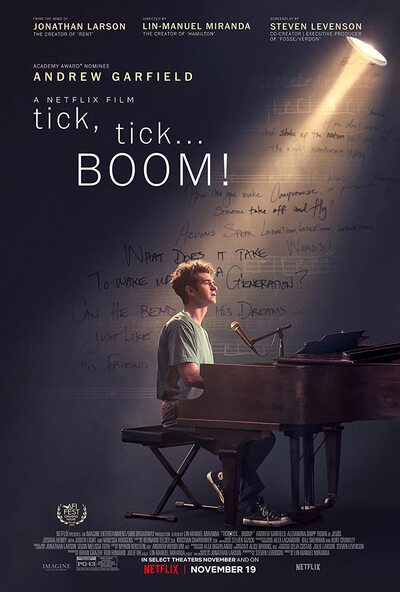 A film adaptation of a stage adaptation of Jonathan Larsen’s one man show, Tick, Tick…BOOM is a Jenga tower built with similar materials. Check the scoreboard: an artist whose birthday is cause for existential panic, a self-referential musical which details the author’s creative process, a deadly (and politicized) pandemic which makes that process feel limp and narcissistic, a generation numbed by an “empty image emanating out of a screen.” When he was 27, Bo’s grandpa fought in Vietnam; when Sondheim was 27, he debuted West Side Story. But while both artists use reflection to convey inner turmoil, they do so in remarkably different ways. Burnham’s hall of mirrors is solitary, downbeat, a dim-lit exorcism of irreconcilable things. Whereas Larsen’s is all bright augmentation, a joyous spiraling upwards. It’s a vocal chorus rising when every instinct says “Resolve!” Consider the standout sequence “Therapy,” one block of the tower at a time. Past-tense Jonathan is in a fight with his girlfriend over a song he hasn’t yet written about her, while present-tense Jonathan performs said song with a partner as her stand-in. The in-song couple wear withering smiles undercut by the insults they’re hurling, but through their facade of thinly-suppressed outrage gleams the performers’ delight at selling the bit.
A film adaptation of a stage adaptation of Jonathan Larsen’s one man show, Tick, Tick…BOOM is a Jenga tower built with similar materials. Check the scoreboard: an artist whose birthday is cause for existential panic, a self-referential musical which details the author’s creative process, a deadly (and politicized) pandemic which makes that process feel limp and narcissistic, a generation numbed by an “empty image emanating out of a screen.” When he was 27, Bo’s grandpa fought in Vietnam; when Sondheim was 27, he debuted West Side Story. But while both artists use reflection to convey inner turmoil, they do so in remarkably different ways. Burnham’s hall of mirrors is solitary, downbeat, a dim-lit exorcism of irreconcilable things. Whereas Larsen’s is all bright augmentation, a joyous spiraling upwards. It’s a vocal chorus rising when every instinct says “Resolve!” Consider the standout sequence “Therapy,” one block of the tower at a time. Past-tense Jonathan is in a fight with his girlfriend over a song he hasn’t yet written about her, while present-tense Jonathan performs said song with a partner as her stand-in. The in-song couple wear withering smiles undercut by the insults they’re hurling, but through their facade of thinly-suppressed outrage gleams the performers’ delight at selling the bit.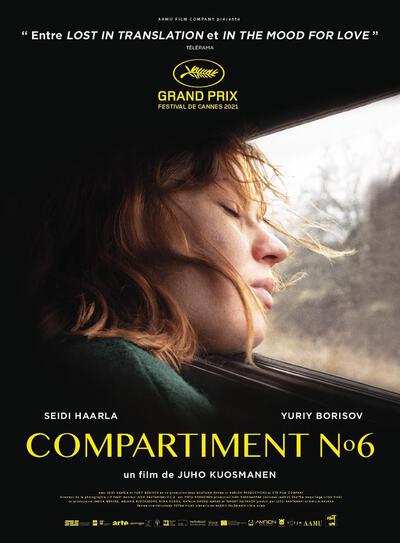 Compartment No. 6 is in no hurry to reveal its destination. The story of two young travelers who find each other on a trans-Siberian train, it’s bound to court comparisons to Richard Linklater. But in truth, their situation shares less with Delpy and Hawke than it does Steve Martin and John Candy. When Laura first meets Ljoha, he seems genuinely abrasive. He downs untold shots of vodka, trespasses over every personal boundary, and carries himself with an air of volatility and menace. Or, at least, that’s how he’s perceived by his companion. The magic of this film is just how nimbly it pulls the rug out from under you—despite also, overtly, calling its shot. I love the way it conveys the wistful openness of travel, that irrepressible desire to bare your soul to a stranger. Barreling through the Russian countryside in their sardine-packed enclosure, Laura and Ljoha slowly start to melt.
Compartment No. 6 is in no hurry to reveal its destination. The story of two young travelers who find each other on a trans-Siberian train, it’s bound to court comparisons to Richard Linklater. But in truth, their situation shares less with Delpy and Hawke than it does Steve Martin and John Candy. When Laura first meets Ljoha, he seems genuinely abrasive. He downs untold shots of vodka, trespasses over every personal boundary, and carries himself with an air of volatility and menace. Or, at least, that’s how he’s perceived by his companion. The magic of this film is just how nimbly it pulls the rug out from under you—despite also, overtly, calling its shot. I love the way it conveys the wistful openness of travel, that irrepressible desire to bare your soul to a stranger. Barreling through the Russian countryside in their sardine-packed enclosure, Laura and Ljoha slowly start to melt.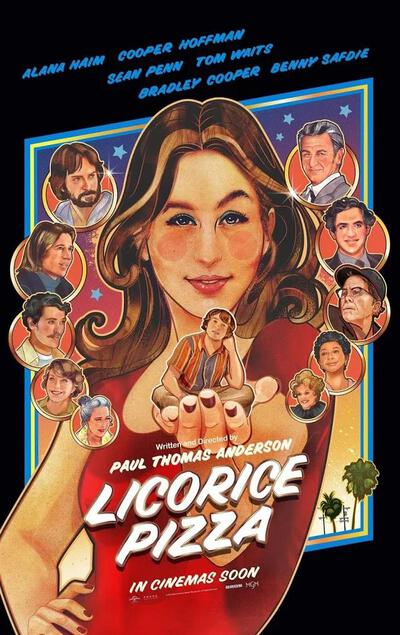 Regardless of The Discourse or the film’s ostensible plot, I don’t view Licorice Pizza as a romance. It doesn’t deal in lovelorn glances, revealing confessions, intimacies liable to linger. No, the image I’m left with is Alana Kane’s smirk: complicit in something she’s been told is beneath her, bemused in spite of her better judgement. The object of her bemusement is Gary Valentine, the brash-talking, 15-year-old huckster-in-training who has gotten them into yet another ridiculous bind. What draws me to this movie is similar to the draw of Bad Trip: it carries us along in its hijinks. It lets us roll with its mischief. As the pair schemes their way through a 1970s San Fernando Valley, we feel the zig-zag of affection and resentment, giddiness and disgust, that defines both young adulthood and mid-adolescence. The characters are far from perfect, and the script has a few truly baffling flaws.
Regardless of The Discourse or the film’s ostensible plot, I don’t view Licorice Pizza as a romance. It doesn’t deal in lovelorn glances, revealing confessions, intimacies liable to linger. No, the image I’m left with is Alana Kane’s smirk: complicit in something she’s been told is beneath her, bemused in spite of her better judgement. The object of her bemusement is Gary Valentine, the brash-talking, 15-year-old huckster-in-training who has gotten them into yet another ridiculous bind. What draws me to this movie is similar to the draw of Bad Trip: it carries us along in its hijinks. It lets us roll with its mischief. As the pair schemes their way through a 1970s San Fernando Valley, we feel the zig-zag of affection and resentment, giddiness and disgust, that defines both young adulthood and mid-adolescence. The characters are far from perfect, and the script has a few truly baffling flaws.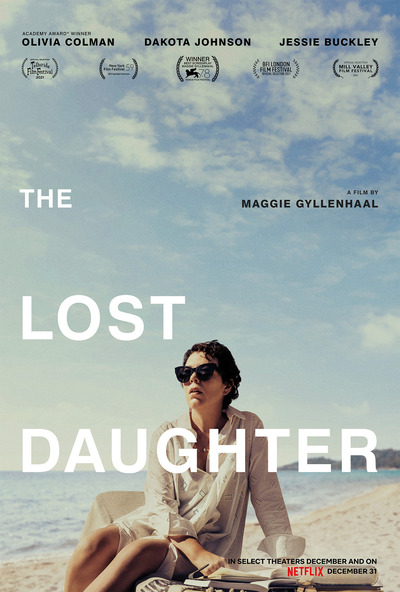 Or, in the case of Leda, a kaleidoscope of paths both chosen and not. The Lost Daughter is one of those beguiling viewing experiences best left unsullied, so I won’t reveal where those potential paths are headed. Instead, I’ll simply walk you through the premise. Leda is a middle-aged professor of comparative literature, visiting a beachside Italian town on a working holiday. Her attempts to relax are continually disrupted, either by her less-than-ideal accommodations (mold in the fruit bowl, cicadas in the bedroom) or, worse, by the uncontrollable behavior of other people. When a young mother and her screaming daughter set up camp on the beach beside her, something internal is jostled loose. What follows is a story about stifled dreams, difficult choices, and the degree to which disillusionment is held up as a virtue. The truism says we don’t always get what we want, but is that a moral imperative or a failure of imagination?
Or, in the case of Leda, a kaleidoscope of paths both chosen and not. The Lost Daughter is one of those beguiling viewing experiences best left unsullied, so I won’t reveal where those potential paths are headed. Instead, I’ll simply walk you through the premise. Leda is a middle-aged professor of comparative literature, visiting a beachside Italian town on a working holiday. Her attempts to relax are continually disrupted, either by her less-than-ideal accommodations (mold in the fruit bowl, cicadas in the bedroom) or, worse, by the uncontrollable behavior of other people. When a young mother and her screaming daughter set up camp on the beach beside her, something internal is jostled loose. What follows is a story about stifled dreams, difficult choices, and the degree to which disillusionment is held up as a virtue. The truism says we don’t always get what we want, but is that a moral imperative or a failure of imagination?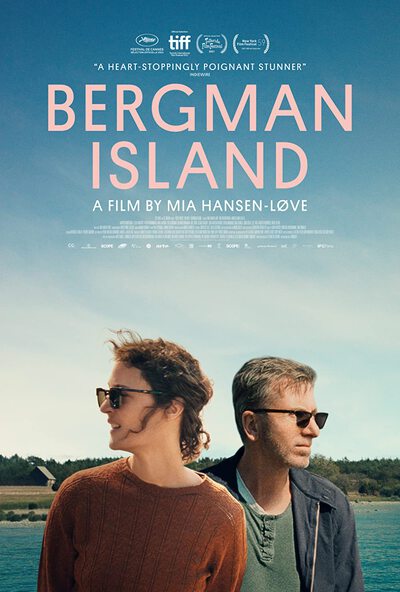 Bergman Island is a similarly slippery work of art. Chris and her partner Tony are independent filmmakers, spending an extended stay on Fårö as they noodle on their scripts. Their Baltic destination, as the title suggests, was immortalized by the films of Ingmar Bergman. Flocks of tourists gather there to idolize his work. But while Tony sees Bergman’s chilly genius as a virtue to be emulated, Chris interrogates the qualities that separate her from both acclaimed men. As the screenplay she writes begins to blur with reality, we’re given access to something, though we can’t quite put a finger on it. A life she longs for but is unable to have? A history which circumstance confined to a footnote? Or is it purely a work of fiction, her characters melding with the desires that inspired them? There are subtle answers to be found as the story progresses, but that reality is hardly the point. The point is the longing that evades intellectual probing, the beauty and risk of an unguarded nerve.
Bergman Island is a similarly slippery work of art. Chris and her partner Tony are independent filmmakers, spending an extended stay on Fårö as they noodle on their scripts. Their Baltic destination, as the title suggests, was immortalized by the films of Ingmar Bergman. Flocks of tourists gather there to idolize his work. But while Tony sees Bergman’s chilly genius as a virtue to be emulated, Chris interrogates the qualities that separate her from both acclaimed men. As the screenplay she writes begins to blur with reality, we’re given access to something, though we can’t quite put a finger on it. A life she longs for but is unable to have? A history which circumstance confined to a footnote? Or is it purely a work of fiction, her characters melding with the desires that inspired them? There are subtle answers to be found as the story progresses, but that reality is hardly the point. The point is the longing that evades intellectual probing, the beauty and risk of an unguarded nerve.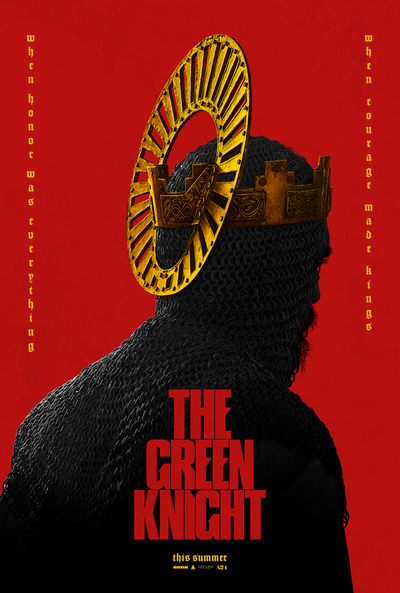 The Green Knight is less a hero’s journey than it is a deconstruction of the concept. Gawain has yet to prove his valor, and so he’s set upon a quest. After lobbing off the titular villain’s head last Christmas, he now must travel to his victim’s lair to receive the same blow in kind. There’s no damsel to rescue, no romanticized end goal. Honor compels him, thus he will go. He’s a living reductio ad absurdum: a man hurtling towards his presumable death in pursuit of an amorphous concept. The story is amorphous and dreamlike in turn, questioning every detail. Is there a mythical King Arthur slaying thousands by hand, or a frail, fragile husk commanding fields full of corpses? Is chastity a virtue to be championed or an act of arrogance, withholding? If a knight is slain in a forest and there’s no witness to observe it, where do all his chivalric moral quandaries go?
The Green Knight is less a hero’s journey than it is a deconstruction of the concept. Gawain has yet to prove his valor, and so he’s set upon a quest. After lobbing off the titular villain’s head last Christmas, he now must travel to his victim’s lair to receive the same blow in kind. There’s no damsel to rescue, no romanticized end goal. Honor compels him, thus he will go. He’s a living reductio ad absurdum: a man hurtling towards his presumable death in pursuit of an amorphous concept. The story is amorphous and dreamlike in turn, questioning every detail. Is there a mythical King Arthur slaying thousands by hand, or a frail, fragile husk commanding fields full of corpses? Is chastity a virtue to be championed or an act of arrogance, withholding? If a knight is slain in a forest and there’s no witness to observe it, where do all his chivalric moral quandaries go?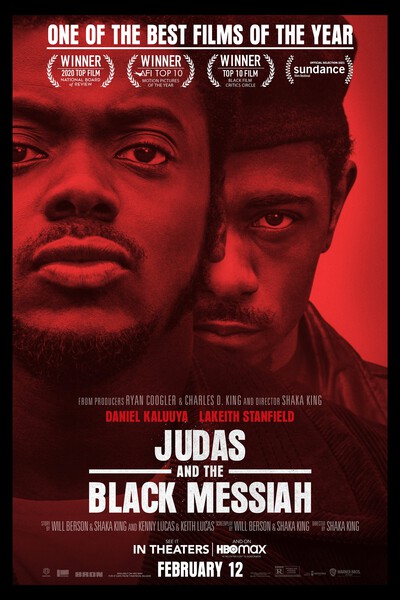 Perhaps the most surprising element of Judas and the Black Messiah is the proportion of screen time devoted to Judas. The Messiah, Fred Hampton, knows exactly where he stands. Recognizing that the powers that be are morally corrupt, he commands a righteous opposition. That war is waged not just through language—though his speeches are electric—but via physical confrontation, if the moment demands it. There’s a gravitational force to everything he does; he pulls us into his orbit. Yet rather than have us view him directly, we watch him through the eyes of Bill O’Neal. Not quite a conman and not quite a disciple, Bill is a wellspring of contradictory impulses and self-justifications. He is, in no uncertain terms, a traitor to the Black Panthers: an FBI informant and a raging egomaniac who will say and do whatever serves him best. But he also feels genuinely emboldened by the movement he’s betraying, seems proud to identify with Fred Hampton’s words. He’s a shape-shifter, an enigma who ping-pongs between clear recognition that “the Law” is unjust, and a desire to wield it, to sanctify his selfishness by it. And in that sense, he is sadly familiar. If decades of status quo enforcement embellished by hope-and-change rhetoric have taught us anything, it’s that Hampton—not O’Neal—was the outlier.
Perhaps the most surprising element of Judas and the Black Messiah is the proportion of screen time devoted to Judas. The Messiah, Fred Hampton, knows exactly where he stands. Recognizing that the powers that be are morally corrupt, he commands a righteous opposition. That war is waged not just through language—though his speeches are electric—but via physical confrontation, if the moment demands it. There’s a gravitational force to everything he does; he pulls us into his orbit. Yet rather than have us view him directly, we watch him through the eyes of Bill O’Neal. Not quite a conman and not quite a disciple, Bill is a wellspring of contradictory impulses and self-justifications. He is, in no uncertain terms, a traitor to the Black Panthers: an FBI informant and a raging egomaniac who will say and do whatever serves him best. But he also feels genuinely emboldened by the movement he’s betraying, seems proud to identify with Fred Hampton’s words. He’s a shape-shifter, an enigma who ping-pongs between clear recognition that “the Law” is unjust, and a desire to wield it, to sanctify his selfishness by it. And in that sense, he is sadly familiar. If decades of status quo enforcement embellished by hope-and-change rhetoric have taught us anything, it’s that Hampton—not O’Neal—was the outlier. Mass functions less as a parable than as a therapy session. Two sets of parents congregate in the basement of a parish. Their goal is, quite simply, to talk. The film doesn’t tell us what they’ve gathered to discuss, and I’d suggest you go in with a similarly blank slate. The beautiful paradox of Mass is that it manages to express something deeper than words, entirely through the medium of four people speaking. They share stories; they argue; they shed many, many tears. It’s difficult at some points to take. But there’s a profound empowerment in seeing it through, an impossible sense of uplift. To experience Mass is to bear witness to something essential, and utterly impervious to melodrama. It’s the human spirit revealing itself on a screen, commanding everything within it to find closure.
Mass functions less as a parable than as a therapy session. Two sets of parents congregate in the basement of a parish. Their goal is, quite simply, to talk. The film doesn’t tell us what they’ve gathered to discuss, and I’d suggest you go in with a similarly blank slate. The beautiful paradox of Mass is that it manages to express something deeper than words, entirely through the medium of four people speaking. They share stories; they argue; they shed many, many tears. It’s difficult at some points to take. But there’s a profound empowerment in seeing it through, an impossible sense of uplift. To experience Mass is to bear witness to something essential, and utterly impervious to melodrama. It’s the human spirit revealing itself on a screen, commanding everything within it to find closure.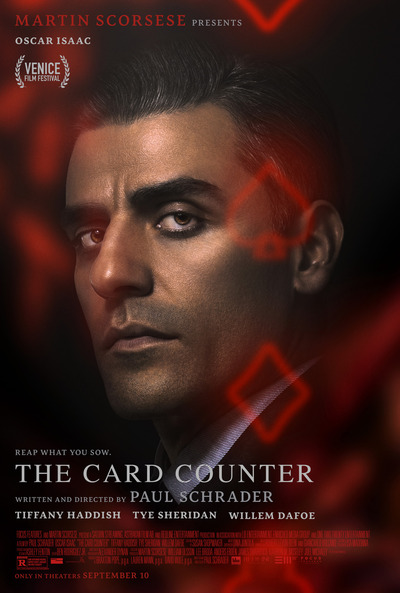 If Mass moves us by speaking the unspeakable, The Card Counter stirs us with silence. William Tell is a man of few words. The convict-turned-professional-gambler has so thoroughly narrowed the scope of his life that it feels like religious observance: He enters a casino, plays hours of poker, then returns to an empty hotel room, where, having covered every surface in muted grey sheets, he proceeds to write down his thoughts in a journal. What he’s dwelling on is, again, best discovered for yourself. But when he meets two other wanderers, he feels the hint of an offramp. In La Linda, the liaison for a group of financial backers, he sees an emotional substitute for confession. And in Cirk, his young protege, he sees a chance at redemption, of cultivating a better future than the one he’s been dealt. As he pours himself into both vessels of hope, we’re drawn deeper into his tormented psyche. It’s a hypnotic, slow motion shattering.
If Mass moves us by speaking the unspeakable, The Card Counter stirs us with silence. William Tell is a man of few words. The convict-turned-professional-gambler has so thoroughly narrowed the scope of his life that it feels like religious observance: He enters a casino, plays hours of poker, then returns to an empty hotel room, where, having covered every surface in muted grey sheets, he proceeds to write down his thoughts in a journal. What he’s dwelling on is, again, best discovered for yourself. But when he meets two other wanderers, he feels the hint of an offramp. In La Linda, the liaison for a group of financial backers, he sees an emotional substitute for confession. And in Cirk, his young protege, he sees a chance at redemption, of cultivating a better future than the one he’s been dealt. As he pours himself into both vessels of hope, we’re drawn deeper into his tormented psyche. It’s a hypnotic, slow motion shattering.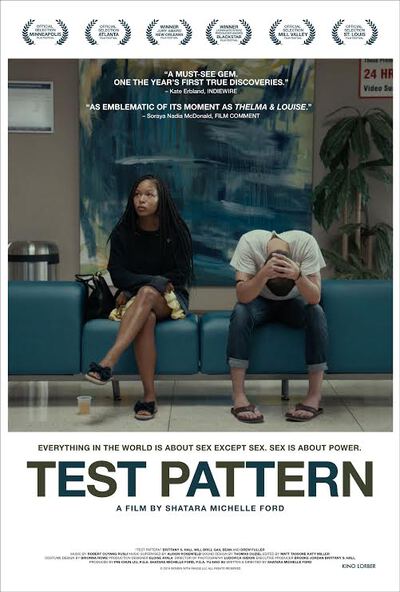 Test Pattern is a damning social critique, and a remarkably effective one at that. Renesha is a self-possessed Black woman eager to climb the corporate ladder; Evan’s a mellow White tattoo artist who seems content to cheer her on. The film documents two days in the couple’s life: an evening when Renesha is assaulted by a stranger, and the morning after, as she and Evan try for hours to find a rape kit. It’s an excoriating portrait of the indignities we force survivors of assault to endure, the litany of bureaucratic roadblocks that seem designed to hinder hope. But the brilliance of the film also lies in its specific characterizations, in the interpersonal fissures their experience reveals. At first, Evan appears to be a paragon of supportive partnerhood: He tends to Renesha’s immediate needs, believes her story without question, and reiterates his commitment to protect her. He leaps into action in service to the woman whom he loves. But as his instinct towards action grows increasingly desperate, a troubling dynamic develops—one that tiptoes the line between support and ownership, between protection as loving impulse and as assertion of control. Through flashbacks that juxtapose their present day dynamic and their history as a couple, we are asked to recontextualize their relationship through the lenses of race, gender, and ultimately power. It’s a sobering (and brutally recognizable) portrayal, one that defies easy answers and didactic conclusions.
Test Pattern is a damning social critique, and a remarkably effective one at that. Renesha is a self-possessed Black woman eager to climb the corporate ladder; Evan’s a mellow White tattoo artist who seems content to cheer her on. The film documents two days in the couple’s life: an evening when Renesha is assaulted by a stranger, and the morning after, as she and Evan try for hours to find a rape kit. It’s an excoriating portrait of the indignities we force survivors of assault to endure, the litany of bureaucratic roadblocks that seem designed to hinder hope. But the brilliance of the film also lies in its specific characterizations, in the interpersonal fissures their experience reveals. At first, Evan appears to be a paragon of supportive partnerhood: He tends to Renesha’s immediate needs, believes her story without question, and reiterates his commitment to protect her. He leaps into action in service to the woman whom he loves. But as his instinct towards action grows increasingly desperate, a troubling dynamic develops—one that tiptoes the line between support and ownership, between protection as loving impulse and as assertion of control. Through flashbacks that juxtapose their present day dynamic and their history as a couple, we are asked to recontextualize their relationship through the lenses of race, gender, and ultimately power. It’s a sobering (and brutally recognizable) portrayal, one that defies easy answers and didactic conclusions.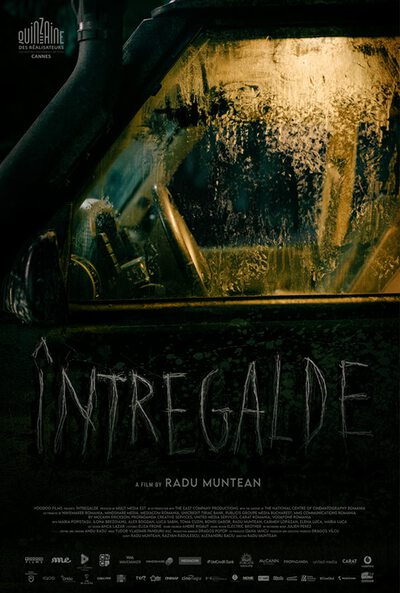 Întregalde pulls off a similar trick in reverse, hiding a damning portrait of society under the trappings of an intimate horror. We follow a group of Romanian aid workers as they drive through rural Transylvania, faithfully delivering goods to those in need. Naturally, they believe themselves to be fundamentally decent: They’ve chosen to volunteer when they could be doing otherwise, to devote their precious time to altruistic pursuits. But when a roadside hitchhiker gives them faulty directions, their lofty ideals start to crumble. They become lost and desperate; their relationships fray; the goal pivots from aid to survival. By nightfall, the very same people they’ve traveled to uplift appear to them as either obstacles or threats. Shrewd, unflinching, and perfectly calibrated, the thriller hooked me from beginning to end. In its closing few minutes, though, it became about something more transcendent: the aching reality of humanitarian crises, and how little they match our rose-tinted projections. We may genuinely care about doing “the right thing,” and we may even be willing to suffer for it—that is, if the suffering has predefined bounds, a controllable burn that feels righteous. But are we willing to embrace the daily tedium, the unpredictable discomforts and unrecognized sacrifices that meaningful, protracted change demands?
Întregalde pulls off a similar trick in reverse, hiding a damning portrait of society under the trappings of an intimate horror. We follow a group of Romanian aid workers as they drive through rural Transylvania, faithfully delivering goods to those in need. Naturally, they believe themselves to be fundamentally decent: They’ve chosen to volunteer when they could be doing otherwise, to devote their precious time to altruistic pursuits. But when a roadside hitchhiker gives them faulty directions, their lofty ideals start to crumble. They become lost and desperate; their relationships fray; the goal pivots from aid to survival. By nightfall, the very same people they’ve traveled to uplift appear to them as either obstacles or threats. Shrewd, unflinching, and perfectly calibrated, the thriller hooked me from beginning to end. In its closing few minutes, though, it became about something more transcendent: the aching reality of humanitarian crises, and how little they match our rose-tinted projections. We may genuinely care about doing “the right thing,” and we may even be willing to suffer for it—that is, if the suffering has predefined bounds, a controllable burn that feels righteous. But are we willing to embrace the daily tedium, the unpredictable discomforts and unrecognized sacrifices that meaningful, protracted change demands?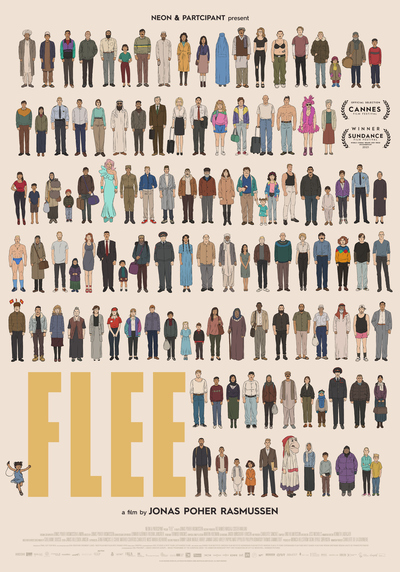 Amin, the subject of the documentary Flee, has been given every reason to keep his story buried. An Afghan refugee now living in Denmark, there’s a certain precarity built into every moment—a fear that everything might crumble if he’s held up to the light. Which is what makes this such a courageous testimony and such a moving work of art. By use of animation (and a host of voice actors), Flee is able to mask incriminating details while bringing Amin’s childhood memories to life. Fluid, impressionistic, and subjective by design, it communicates emotional undercurrents mere depiction would obscure. Much of this is heartbreaking, though not always in the manner we’ve been primed to expect. We’re reminded that “refugee crisis” is a blanket term, covering countless complex individuals, and that suffering doesn’t operate on relative scales. No statistic could encompass Amin’s reality.
Amin, the subject of the documentary Flee, has been given every reason to keep his story buried. An Afghan refugee now living in Denmark, there’s a certain precarity built into every moment—a fear that everything might crumble if he’s held up to the light. Which is what makes this such a courageous testimony and such a moving work of art. By use of animation (and a host of voice actors), Flee is able to mask incriminating details while bringing Amin’s childhood memories to life. Fluid, impressionistic, and subjective by design, it communicates emotional undercurrents mere depiction would obscure. Much of this is heartbreaking, though not always in the manner we’ve been primed to expect. We’re reminded that “refugee crisis” is a blanket term, covering countless complex individuals, and that suffering doesn’t operate on relative scales. No statistic could encompass Amin’s reality.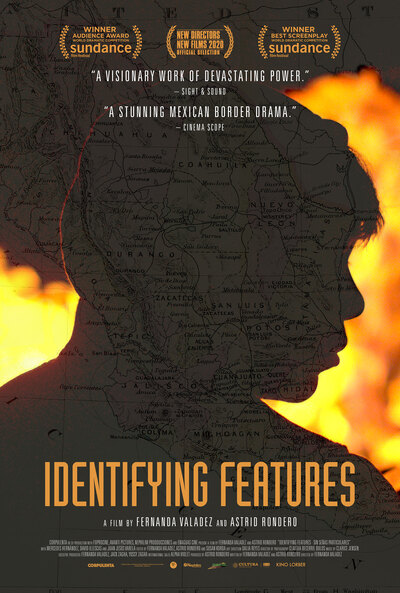 If Flee is a documentary that moves with the fluidity of fiction, Identifying Features is a work of ethereal fiction that hits with the weight of documentary. Magdalena’s son, Jesús, set off from home to cross the U.S. border. But in the intervening months, she has yet to hear a word. If the silence is deafening, the news that follows it is worse: The body of Jesús’ traveling companion has been positively identified. Like far too many real-world emigrants, he perished on the journey. No cause of death is given, nor is its absence noted: It’s as if this simply happened, like some stochastic social tax. Thus begins a somber quest, as Magdalena heads north in search of closure. What’s stunning about the experience is how little a window we are offered. She rides the bus in silence; she waits patiently in line; she leafs through photographs of bodies and possessions with methodical persistence. Rather than expressing grief outright, we are made to absorb it through osmosis: through wordless exchanges, sparse encounters, landscapes thrumming with negative space. One particularly stunning scene involves a second-hand memory, foggy and uncertain, as dreamlike as any drawn in Flee. But the details of this memory remain (intentionally) untranslated, narrated in an indigenous tongue Magdalena doesn’t speak. Absent the symbolic, the abstract finality of language, we can only connect by way of feeling. We receive, instead, precisely what we must.
If Flee is a documentary that moves with the fluidity of fiction, Identifying Features is a work of ethereal fiction that hits with the weight of documentary. Magdalena’s son, Jesús, set off from home to cross the U.S. border. But in the intervening months, she has yet to hear a word. If the silence is deafening, the news that follows it is worse: The body of Jesús’ traveling companion has been positively identified. Like far too many real-world emigrants, he perished on the journey. No cause of death is given, nor is its absence noted: It’s as if this simply happened, like some stochastic social tax. Thus begins a somber quest, as Magdalena heads north in search of closure. What’s stunning about the experience is how little a window we are offered. She rides the bus in silence; she waits patiently in line; she leafs through photographs of bodies and possessions with methodical persistence. Rather than expressing grief outright, we are made to absorb it through osmosis: through wordless exchanges, sparse encounters, landscapes thrumming with negative space. One particularly stunning scene involves a second-hand memory, foggy and uncertain, as dreamlike as any drawn in Flee. But the details of this memory remain (intentionally) untranslated, narrated in an indigenous tongue Magdalena doesn’t speak. Absent the symbolic, the abstract finality of language, we can only connect by way of feeling. We receive, instead, precisely what we must.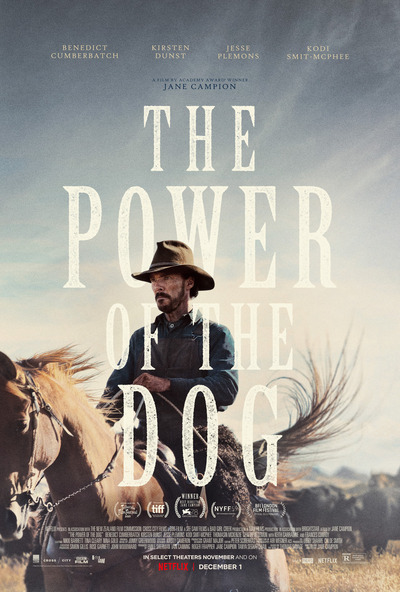 Menace clings to every frame in The Power of the Dog. Befitting a Gothic Western set in 1920s Montana, some of that comes with the territory: stampeding animals, tumbleweed rot, death as a daily intrusion. But if the wilderness demands a certain jaggedness from everyone, Phil seems to particularly luxuriate in it. He’s a gaping wound with a dirty rag draped over it. He wants it to fester, and wants you to know it. When his brother’s wife Rose and her son come to live with him, he marks them as “soft” and sets on a mission to break them: caustic looks, half-uttered insults, a nearly invisible tightening of screws. Even if Rose could confide in her husband, what tangible proof could she offer? Phil’s contempt is so strong it needs no physical medium; he plucks at her flaws with virtuosic precision. You’ve seen enough movies (or read enough of that intro) to intuit where all this is going. Yet far from spoiling the experience, that intuition is just another instrument, one the film will play with similarly unnerving expertise. The Power of the Dog aims to make something inside of us curdle, to blur the lines between protection and violence. It compels us to recognize the rot from within.
Menace clings to every frame in The Power of the Dog. Befitting a Gothic Western set in 1920s Montana, some of that comes with the territory: stampeding animals, tumbleweed rot, death as a daily intrusion. But if the wilderness demands a certain jaggedness from everyone, Phil seems to particularly luxuriate in it. He’s a gaping wound with a dirty rag draped over it. He wants it to fester, and wants you to know it. When his brother’s wife Rose and her son come to live with him, he marks them as “soft” and sets on a mission to break them: caustic looks, half-uttered insults, a nearly invisible tightening of screws. Even if Rose could confide in her husband, what tangible proof could she offer? Phil’s contempt is so strong it needs no physical medium; he plucks at her flaws with virtuosic precision. You’ve seen enough movies (or read enough of that intro) to intuit where all this is going. Yet far from spoiling the experience, that intuition is just another instrument, one the film will play with similarly unnerving expertise. The Power of the Dog aims to make something inside of us curdle, to blur the lines between protection and violence. It compels us to recognize the rot from within.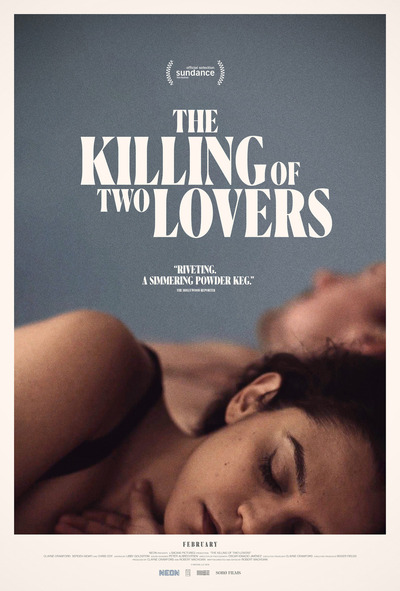 The Power of the Dog reveals its characters’ torment methodically; The Killing of Two Lovers exposes it in the opening scene. We begin with the sound of David breathing, amid some industrial clatter. We then see his face, framed in claustrophobic aspect, before a cut reveals the still-sleeping couple by his side. One of them is Nikki, his wife and mother of his children. The other, as of now, remains a stranger. David’s looking down at them with such a childlike hurt, we feel a pang of pity…that is, until we see the pistol he’s aimed squarely at their heads. He won’t pull the trigger, at least not yet. But that uneasy juxtaposition—the boyish look in close-up, the loaded gun in wide—it permeates the rest of the film. Outwardly David seems like an affable guy, a father coping with separation as well as one might expect. He picks the kids up, on time and excited; he spends hours memorizing Hedberg riffs to quote back to his boys. When his eldest daughter expresses hatred for her mother, he responds with the conviction of a Very Special Episode: marriage is hard, Nikki’s a wonderful woman, everybody’s trying their best. And yet, there was the gun, and the innocent expression as he held it. For long stretches of the film we’re shown nothing of the weapon, but that whiff of boyish charm serves as a proximate threat. We stay lodged in that discrepancy like a bullet in the chamber, waiting for some inevitable release.
The Power of the Dog reveals its characters’ torment methodically; The Killing of Two Lovers exposes it in the opening scene. We begin with the sound of David breathing, amid some industrial clatter. We then see his face, framed in claustrophobic aspect, before a cut reveals the still-sleeping couple by his side. One of them is Nikki, his wife and mother of his children. The other, as of now, remains a stranger. David’s looking down at them with such a childlike hurt, we feel a pang of pity…that is, until we see the pistol he’s aimed squarely at their heads. He won’t pull the trigger, at least not yet. But that uneasy juxtaposition—the boyish look in close-up, the loaded gun in wide—it permeates the rest of the film. Outwardly David seems like an affable guy, a father coping with separation as well as one might expect. He picks the kids up, on time and excited; he spends hours memorizing Hedberg riffs to quote back to his boys. When his eldest daughter expresses hatred for her mother, he responds with the conviction of a Very Special Episode: marriage is hard, Nikki’s a wonderful woman, everybody’s trying their best. And yet, there was the gun, and the innocent expression as he held it. For long stretches of the film we’re shown nothing of the weapon, but that whiff of boyish charm serves as a proximate threat. We stay lodged in that discrepancy like a bullet in the chamber, waiting for some inevitable release.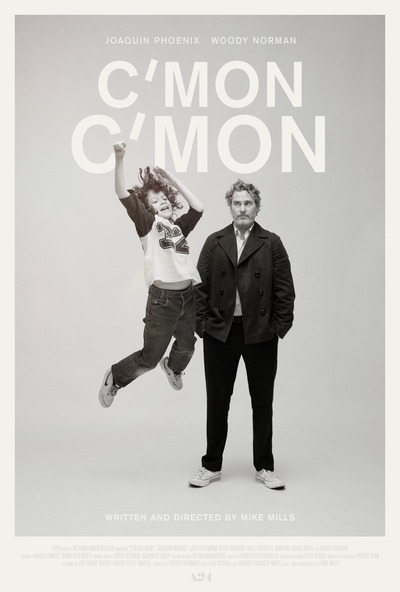 A man and a boy are walking together through a black-and-white, bustling Manhattan. Johnny is weary and pensive, probably in his late 40’s; his fidgeting nephew Jesse is 9. Jesse’s never been to The City before, and he’s wired on cacophony and sugar: head bobbing, limbs squirming, eyes strained in an effort to see everywhere at once. He’s a human antenna, donning headphones designed for a head twice his size and waving a big, fluffy microphone. Johnny’s patiently suggesting recording techniques, but Jesse’s way too excited to listen. They’ll capture it together, somehow. C’mon C’mon is a movie that documents life as we live it, and I realize that makes it sound cheesy. That’s okay. Whether you’re a jittery nine-year-old brimming with questions or an adult too exhausted for answers, a great deal of your life is certain to be cheesy—and forgotten. How many late night epiphanies can you still recall? What’s the half life of a fit of unexplained laughter—the kind that hit without warning and slowly devolved into dumb, incommunicable tears? Their mic is storing this to tape, but would it matter if it weren’t? It’s the intention to preserve that renders the feeling immortal. “I’ll remind you of everything.”
A man and a boy are walking together through a black-and-white, bustling Manhattan. Johnny is weary and pensive, probably in his late 40’s; his fidgeting nephew Jesse is 9. Jesse’s never been to The City before, and he’s wired on cacophony and sugar: head bobbing, limbs squirming, eyes strained in an effort to see everywhere at once. He’s a human antenna, donning headphones designed for a head twice his size and waving a big, fluffy microphone. Johnny’s patiently suggesting recording techniques, but Jesse’s way too excited to listen. They’ll capture it together, somehow. C’mon C’mon is a movie that documents life as we live it, and I realize that makes it sound cheesy. That’s okay. Whether you’re a jittery nine-year-old brimming with questions or an adult too exhausted for answers, a great deal of your life is certain to be cheesy—and forgotten. How many late night epiphanies can you still recall? What’s the half life of a fit of unexplained laughter—the kind that hit without warning and slowly devolved into dumb, incommunicable tears? Their mic is storing this to tape, but would it matter if it weren’t? It’s the intention to preserve that renders the feeling immortal. “I’ll remind you of everything.” That line could easily have been uttered by Robin, the monklike protagonist of Pig. Having emerged from the forest after years of self-imposed seclusion, the chef functions as a conscious well of memory. It isn’t just that he remembers on behalf of other people (though he recalls every meal he’s cooked and every patron whom he’s served). It’s that his very demeanor—unflinching directness, uncanny attunement, ability to coax out the senses in others—it acts as a catalyst. Robin encourages; he conjures; he makes space for remembrance. A mystical meditation on the power of presence, Pig tells us that to fully experience a moment is to commune with its history. Every sense memory is a security deposit box, an underground truffle, a bottled vintage nestled under layers of dust: tiny, hidden Horcruxes, fragments of ourselves, containers of a prior present waiting to be uncorked. The best meal of your life. A film that makes you cry. A now-empty restaurant whose clattering once covered a thousand whispered intimacies. By staying open to the immediate, we become historians and time travelers: present in memory, transparent in hurt, connected to others, clarified to ourselves, unburdened, unwavering, unexpectant, unguarded, unhurried, relaxed, resilient, and found.
That line could easily have been uttered by Robin, the monklike protagonist of Pig. Having emerged from the forest after years of self-imposed seclusion, the chef functions as a conscious well of memory. It isn’t just that he remembers on behalf of other people (though he recalls every meal he’s cooked and every patron whom he’s served). It’s that his very demeanor—unflinching directness, uncanny attunement, ability to coax out the senses in others—it acts as a catalyst. Robin encourages; he conjures; he makes space for remembrance. A mystical meditation on the power of presence, Pig tells us that to fully experience a moment is to commune with its history. Every sense memory is a security deposit box, an underground truffle, a bottled vintage nestled under layers of dust: tiny, hidden Horcruxes, fragments of ourselves, containers of a prior present waiting to be uncorked. The best meal of your life. A film that makes you cry. A now-empty restaurant whose clattering once covered a thousand whispered intimacies. By staying open to the immediate, we become historians and time travelers: present in memory, transparent in hurt, connected to others, clarified to ourselves, unburdened, unwavering, unexpectant, unguarded, unhurried, relaxed, resilient, and found.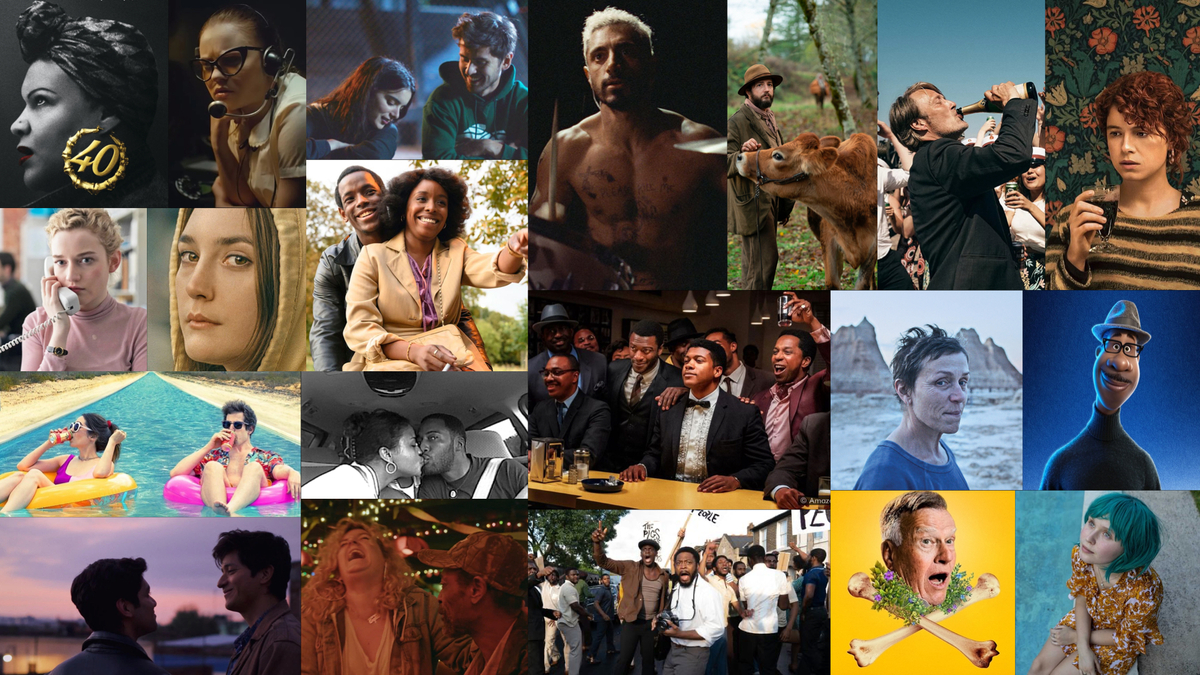
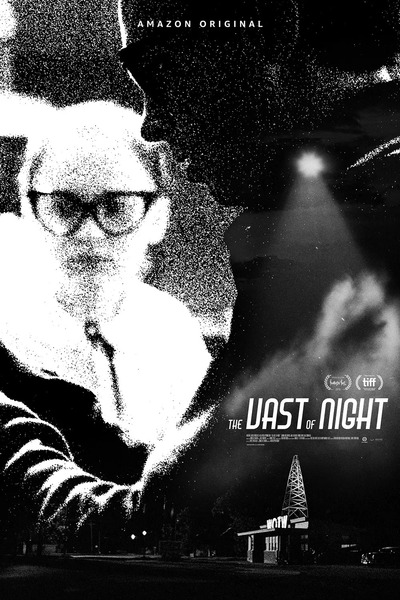 The Vast Of Night is an ode to that pervasive sense of wonder; the truth that tiny revelations could be hiding in plain sight. Even—especially—in those places where nothing seems to happen. A cloistered, quiet town with a gee-aw-shucks aesthetic. An evening radio program without a soul who’s calling in. A house that hasn’t seen a visitor in ages; a woman sitting there in silence, waiting for you to speak. With age we might grow numb to it, but in youth we knew the stakes. Curiosity is a muscle and it takes will to exercise it. Many will spend a lifetime looking forward, none the wiser. But ask the right question, tune to the right frequency, lift your eyes skyward, and you just might catch a glimpse.
The Vast Of Night is an ode to that pervasive sense of wonder; the truth that tiny revelations could be hiding in plain sight. Even—especially—in those places where nothing seems to happen. A cloistered, quiet town with a gee-aw-shucks aesthetic. An evening radio program without a soul who’s calling in. A house that hasn’t seen a visitor in ages; a woman sitting there in silence, waiting for you to speak. With age we might grow numb to it, but in youth we knew the stakes. Curiosity is a muscle and it takes will to exercise it. Many will spend a lifetime looking forward, none the wiser. But ask the right question, tune to the right frequency, lift your eyes skyward, and you just might catch a glimpse. Incuriosity doesn’t always look like passivity; sometimes it looks like striving. Soul’s Joe Gardner isn’t lacking in motivation. Far from it. He knows what he wants, knows how to get it, and even knows how to make it transcendent: those moments on a piano bench when the world swirls to the periphery. His problem isn’t a failure to aim higher; it’s limiting the scope of his gaze. If being “swept up in the music” is the sole jurisdiction the stage, or “discovery” restricted to a distant, dim-lit runway, then it’s a fragile source of meaning, prone to wild fluctuations. His joy will always be beholden to his striving. A good steward of wonder ought to keep their portfolio diverse. Luckily, there is no shortage of options.
Incuriosity doesn’t always look like passivity; sometimes it looks like striving. Soul’s Joe Gardner isn’t lacking in motivation. Far from it. He knows what he wants, knows how to get it, and even knows how to make it transcendent: those moments on a piano bench when the world swirls to the periphery. His problem isn’t a failure to aim higher; it’s limiting the scope of his gaze. If being “swept up in the music” is the sole jurisdiction the stage, or “discovery” restricted to a distant, dim-lit runway, then it’s a fragile source of meaning, prone to wild fluctuations. His joy will always be beholden to his striving. A good steward of wonder ought to keep their portfolio diverse. Luckily, there is no shortage of options. When we meet Sibil Fox Richardson in Time, she has reason to be discouraged. Her husband is serving a potentially life sentence for a confessed (nonviolent) crime. Despite a mountain of legal fees and failed appeals, things have shown little sign of changing. When her children were born, Rob was behind bars; when they graduated high school, he was still behind bars. She acknowledges her situation, and works to rise above it: working multiple jobs, taking public speaking gigs, partnering with criminal justice advocacy groups. But pragmatism alone can’t withstand 21 years of separation. It’s her love that keeps the family together, and hope that keeps them moving forward: phone calls, visits, filmed Big Moments, even a life-sized cardboard cutout. Her hope for her husband’s freedom is far more than some empty coping mechanism. It’s a vital attribute on which his freedom will depend.
When we meet Sibil Fox Richardson in Time, she has reason to be discouraged. Her husband is serving a potentially life sentence for a confessed (nonviolent) crime. Despite a mountain of legal fees and failed appeals, things have shown little sign of changing. When her children were born, Rob was behind bars; when they graduated high school, he was still behind bars. She acknowledges her situation, and works to rise above it: working multiple jobs, taking public speaking gigs, partnering with criminal justice advocacy groups. But pragmatism alone can’t withstand 21 years of separation. It’s her love that keeps the family together, and hope that keeps them moving forward: phone calls, visits, filmed Big Moments, even a life-sized cardboard cutout. Her hope for her husband’s freedom is far more than some empty coping mechanism. It’s a vital attribute on which his freedom will depend.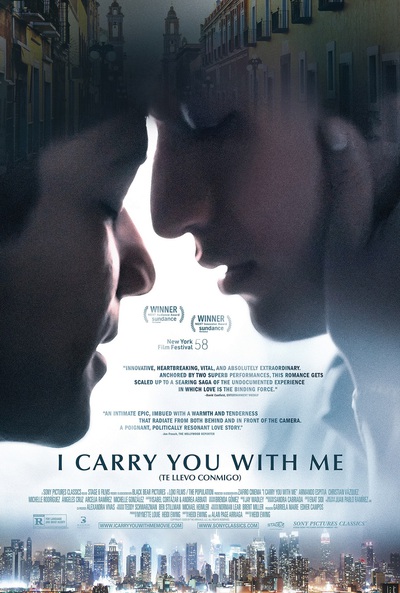 I Carry You With Me is also about a hope that insists upon itself, regardless of the roadblock. Iván and Gerardo fall in love despite families who won’t accept them. Hope then propels them to seek opportunity in a place that won’t receive them. And when the city threatens to crush them—when poverty is more than they can stand—hope encourages them to continue pressing on. Despite decades defined by forced separations between lover and lover, then father and son, they carve out a piece of the American dream…one that is endlessly threatened by the country that brands it. Still, they endure. They demand a better life. And they bridge all borders in the process: hometown and home, acquaintance and family, documentary and fiction.
I Carry You With Me is also about a hope that insists upon itself, regardless of the roadblock. Iván and Gerardo fall in love despite families who won’t accept them. Hope then propels them to seek opportunity in a place that won’t receive them. And when the city threatens to crush them—when poverty is more than they can stand—hope encourages them to continue pressing on. Despite decades defined by forced separations between lover and lover, then father and son, they carve out a piece of the American dream…one that is endlessly threatened by the country that brands it. Still, they endure. They demand a better life. And they bridge all borders in the process: hometown and home, acquaintance and family, documentary and fiction.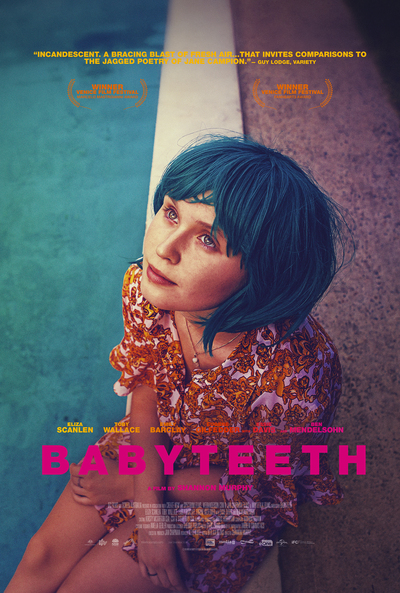 When confronted with trauma, most characters in Babyteeth run in the opposite direction. Milla’s father (a psychiatrist) keeps his feelings bottled up, and keeps his wife’s suspended in a dull prescription haze. Moses hides his loss behind a veil of liberation: he is free to do whatever he wishes, provided it destroys him. Free to run at breakneck speeds towards an oncoming train; free to break into Milla’s parents’ house (but not his family home). Only Milla, 16 years old and facing terminal cancer, seems willing to look the monster in the eye. Like American Honey’s rowdy van crew, swerving towards salvation, her methods may seem ill-advised, immature, or careless. But she’s closer to the truth than all the adults who try to numb it out.
When confronted with trauma, most characters in Babyteeth run in the opposite direction. Milla’s father (a psychiatrist) keeps his feelings bottled up, and keeps his wife’s suspended in a dull prescription haze. Moses hides his loss behind a veil of liberation: he is free to do whatever he wishes, provided it destroys him. Free to run at breakneck speeds towards an oncoming train; free to break into Milla’s parents’ house (but not his family home). Only Milla, 16 years old and facing terminal cancer, seems willing to look the monster in the eye. Like American Honey’s rowdy van crew, swerving towards salvation, her methods may seem ill-advised, immature, or careless. But she’s closer to the truth than all the adults who try to numb it out.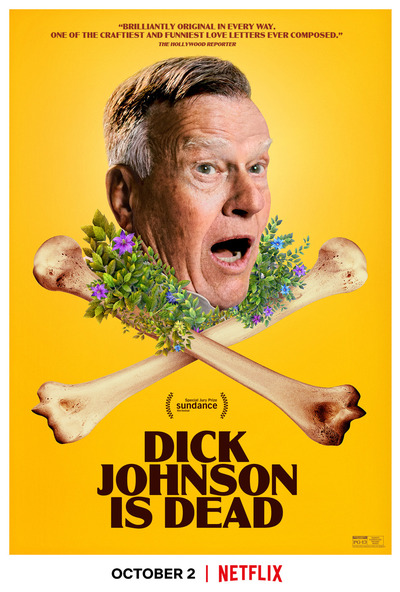 Kirsten Johnson doesn’t want to flee from it. In the title alone, she puts her cards on the table: Dick Johnson Is Dead. The eponymous Dick is losing his memory, and one day he will die. There’s no fixing it or slowing it; there’s no equivalent vaccine. The best the father/daughter duo can do is serve as creative consultants. And so, Dick begins play-acting his inevitable future, even as the spectre of it creeps into his present. He’s knocked out by a wooden plank; he tumbles down the stairs; a window AC unit falls directly on his head. He attends his own funeral, bawls through the eulogy, and dances with his departed wife in a bedazzled, cotton candy heaven. It may sound depressing, but it genuinely is not: By fictionalizing his own mortality, he’s somehow made it lovely. There are tragic possibilities beyond any of our control. Still, with a buoyancy of spirit and bit of trick photography, we can make the choice to elevate the narrative.
Kirsten Johnson doesn’t want to flee from it. In the title alone, she puts her cards on the table: Dick Johnson Is Dead. The eponymous Dick is losing his memory, and one day he will die. There’s no fixing it or slowing it; there’s no equivalent vaccine. The best the father/daughter duo can do is serve as creative consultants. And so, Dick begins play-acting his inevitable future, even as the spectre of it creeps into his present. He’s knocked out by a wooden plank; he tumbles down the stairs; a window AC unit falls directly on his head. He attends his own funeral, bawls through the eulogy, and dances with his departed wife in a bedazzled, cotton candy heaven. It may sound depressing, but it genuinely is not: By fictionalizing his own mortality, he’s somehow made it lovely. There are tragic possibilities beyond any of our control. Still, with a buoyancy of spirit and bit of trick photography, we can make the choice to elevate the narrative.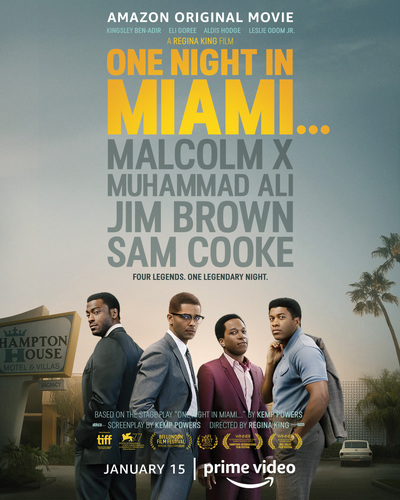 To the four main interlocutors of One Night In Miami, the answer’s not as obvious as it appears on first inspection. In broad strokes, of course, they all agree: the goal is to combat a racist system. But the devil is in the details. To Cassius Clay, the answer lies in rising above the system: excellence and fearless self-identification. To Jim Brown and Sam Cooke, it’s about cleverly exploiting the system from within: slowly amassing power and inspiring others to do the same, till eventually it tips toward an equitable direction. If that maneuver demands a sacrifice, surely the ends justify the means? But to Malcolm X, no nudge can salvage a country that’s rotten to the core: The only way to fix it is to burn the system down. A half century later, as history tragically reverberates, it’s hard to shake the prescience of his words.
To the four main interlocutors of One Night In Miami, the answer’s not as obvious as it appears on first inspection. In broad strokes, of course, they all agree: the goal is to combat a racist system. But the devil is in the details. To Cassius Clay, the answer lies in rising above the system: excellence and fearless self-identification. To Jim Brown and Sam Cooke, it’s about cleverly exploiting the system from within: slowly amassing power and inspiring others to do the same, till eventually it tips toward an equitable direction. If that maneuver demands a sacrifice, surely the ends justify the means? But to Malcolm X, no nudge can salvage a country that’s rotten to the core: The only way to fix it is to burn the system down. A half century later, as history tragically reverberates, it’s hard to shake the prescience of his words.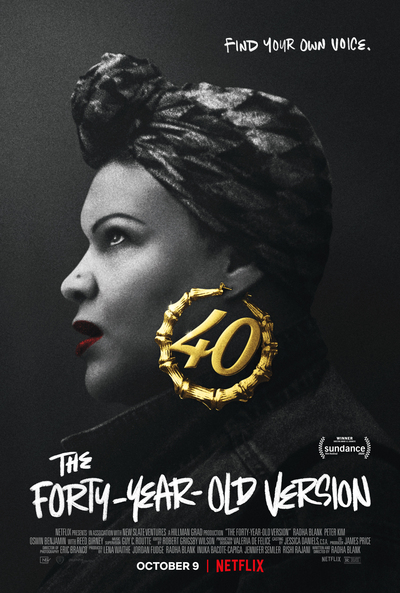 Radha Blank is living in that “half century later”, and her dilemma in The Forty-Year-Old Version is eerily similar to Cooke’s. Overt racism may have been traded in for smiling condescension, but the resulting power structures are more or less the same. In order to succeed as a playwright, she finds herself beholden to white sensibilities: white producers with a hunger for “poverty porn,” white directors on the marquee because “all the others were taken,” white audiences who pay to be “challenged” precisely to a Hamilton-sized point. She’s a flesh and blood artist in a feel-good PR world, one that claims to crave diversity while dictating the contours it must take. And so she finds herself trapped between two competing types of silence. How can authenticity inspire if it means toiling in obscurity? Then again, what’s the value of a platform if it’s in someone else’s voice? With no good option offered to her, she creates one of her own.
Radha Blank is living in that “half century later”, and her dilemma in The Forty-Year-Old Version is eerily similar to Cooke’s. Overt racism may have been traded in for smiling condescension, but the resulting power structures are more or less the same. In order to succeed as a playwright, she finds herself beholden to white sensibilities: white producers with a hunger for “poverty porn,” white directors on the marquee because “all the others were taken,” white audiences who pay to be “challenged” precisely to a Hamilton-sized point. She’s a flesh and blood artist in a feel-good PR world, one that claims to crave diversity while dictating the contours it must take. And so she finds herself trapped between two competing types of silence. How can authenticity inspire if it means toiling in obscurity? Then again, what’s the value of a platform if it’s in someone else’s voice? With no good option offered to her, she creates one of her own.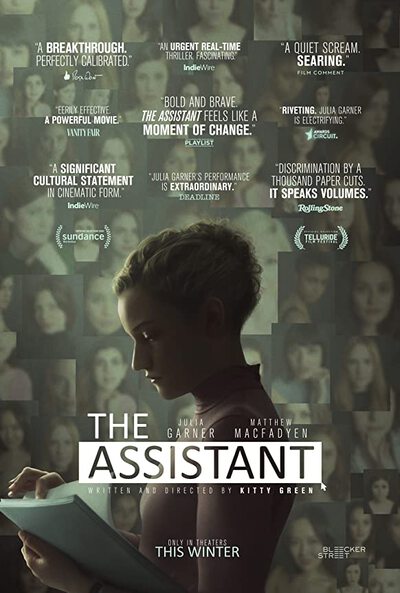 The Assistant’s nameless villain is easy to recognize—the real life man he’s sketched from as well as his cookie-cutter imitations. But while Jane’s boss is surely a monster, he’s not presented as the film’s primary threat. The true source of horror comes from the people in her orbit: the monochromatic pack of yes-men who excuse him, insulate him, turn a blind eye with a smirk. While he remains lurking in the background, they are brought starkly into focus. It’s the coworkers who dictate her servile apology while looming just behind her; the dead-eyed HR rep who wields “listening” like a weapon; the conference room attendee who gives a look that makes simple pleasures feel like stealing. As we follow Jane through a single, hellish workday, we don’t need to hear the abuser directly to understand how he exists. If we tune to different frequencies, we can make it out clearly: the hum of abuse in the system’s design.
The Assistant’s nameless villain is easy to recognize—the real life man he’s sketched from as well as his cookie-cutter imitations. But while Jane’s boss is surely a monster, he’s not presented as the film’s primary threat. The true source of horror comes from the people in her orbit: the monochromatic pack of yes-men who excuse him, insulate him, turn a blind eye with a smirk. While he remains lurking in the background, they are brought starkly into focus. It’s the coworkers who dictate her servile apology while looming just behind her; the dead-eyed HR rep who wields “listening” like a weapon; the conference room attendee who gives a look that makes simple pleasures feel like stealing. As we follow Jane through a single, hellish workday, we don’t need to hear the abuser directly to understand how he exists. If we tune to different frequencies, we can make it out clearly: the hum of abuse in the system’s design. If a collective pact of silence can prop up an abusive system, a collective shout might have a fighting chance at knocking it down. The police who raid The Mangrove are powerful and shameless: they topple tables, smash bottles, and accost its patrons with impunity. And in August 1970, after a long string of abuses, the Afro-Caribbean community of Notting Hill chooses to fight back. They march. They riot. They are arrested and detained by forces which show no interest in their testimony. But through a grueling courtroom battle, they stand united in their witness. They refuse to fold under pressure; they insist on naming the monster. And though a half century later we still hear the echo of abuses, we also hear the voices of those who dared to call it out: bold, unwavering, defiant.
If a collective pact of silence can prop up an abusive system, a collective shout might have a fighting chance at knocking it down. The police who raid The Mangrove are powerful and shameless: they topple tables, smash bottles, and accost its patrons with impunity. And in August 1970, after a long string of abuses, the Afro-Caribbean community of Notting Hill chooses to fight back. They march. They riot. They are arrested and detained by forces which show no interest in their testimony. But through a grueling courtroom battle, they stand united in their witness. They refuse to fold under pressure; they insist on naming the monster. And though a half century later we still hear the echo of abuses, we also hear the voices of those who dared to call it out: bold, unwavering, defiant.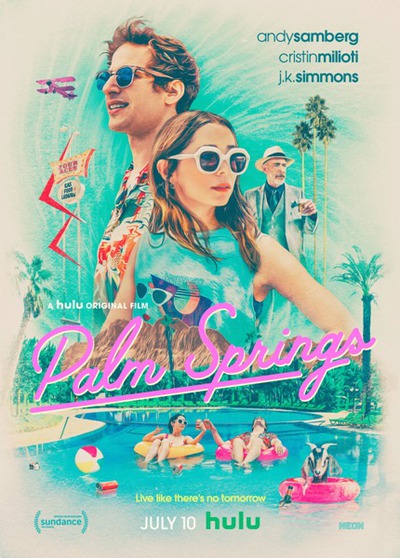 “Absurdity” is the operative word for the protagonists of Palm Springs. Caught in a loop at a destination wedding, they’ve found themselves on the inside of a Camus hypothetical. Social niceties dissolve; distractions prove impermanent; all goal-oriented striving seems meaningless from the jump. They’ve come at it from a thousand angles, and still the stone is rolling. What’s the point in trying to shake things loose? Maybe there’s really nothing left to do but lay back in a pool floatie (with a dozen Akuparas) and let life just happen to them, ad nauseam absurdum. Or is there a reason to push back against their daily, mundane comforts? “Less mundane,” Nyles considers, “That’s a super low bar. That’s a great place to start.”
“Absurdity” is the operative word for the protagonists of Palm Springs. Caught in a loop at a destination wedding, they’ve found themselves on the inside of a Camus hypothetical. Social niceties dissolve; distractions prove impermanent; all goal-oriented striving seems meaningless from the jump. They’ve come at it from a thousand angles, and still the stone is rolling. What’s the point in trying to shake things loose? Maybe there’s really nothing left to do but lay back in a pool floatie (with a dozen Akuparas) and let life just happen to them, ad nauseam absurdum. Or is there a reason to push back against their daily, mundane comforts? “Less mundane,” Nyles considers, “That’s a super low bar. That’s a great place to start.”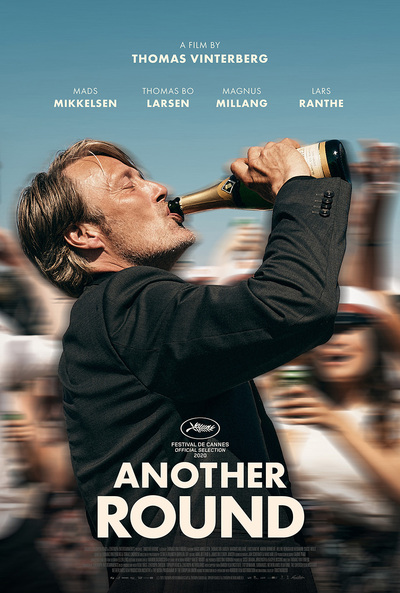 The characters in Another Round are also seeking an escape from the mundane, though their problem isn’t repetition so much an anhedonic rut. Students who don’t give a damn; rote and loveless marriages. That gnawing sense that life has nothing new to offer. And so they do what you or I might when facing a mid-life crisis: They pour themselves a drink. Except they aren’t using alcohol to numb the world, as most films would depict it. No, they’re drinking with the intent of more fully experiencing the world; taking a sledgehammer to their inhibitions to see what’s on the other side. What follows is a sort of guerilla academic study…or at least that’s the excuse. Some of their discoveries are absolutely hilarious. Others are extraordinarily depressing. Even an unchecked hunt for novelty can become its own calcified routine. But there’s a profane wisdom at the heart of their ill-advised experiment, and a vicarious thrill in watching the demolition.
The characters in Another Round are also seeking an escape from the mundane, though their problem isn’t repetition so much an anhedonic rut. Students who don’t give a damn; rote and loveless marriages. That gnawing sense that life has nothing new to offer. And so they do what you or I might when facing a mid-life crisis: They pour themselves a drink. Except they aren’t using alcohol to numb the world, as most films would depict it. No, they’re drinking with the intent of more fully experiencing the world; taking a sledgehammer to their inhibitions to see what’s on the other side. What follows is a sort of guerilla academic study…or at least that’s the excuse. Some of their discoveries are absolutely hilarious. Others are extraordinarily depressing. Even an unchecked hunt for novelty can become its own calcified routine. But there’s a profane wisdom at the heart of their ill-advised experiment, and a vicarious thrill in watching the demolition.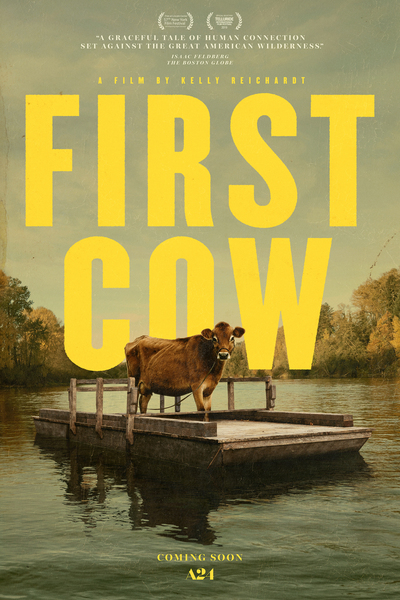 The untamed West of First Cow puts little stock in personal connection. In a time and place defined by dogmatic individualism—boundless expansion, the elusive promise of gold—you are only deemed as “valuable” as the service you provide. When they meet, King-Lu and Cookie have found themselves victims of that cold calculus, and they hope (like so many) to eventually tip the scales. But while their story functions neatly as an economic parable, its real beating heart lies in subtler exchanges. It’s the unassuming manner in which Cookie sweeps the floor; the way King-Lu voices an idea as if he could see it in the distance. It’s about the spirit of friendship, impervious to circumstance, which can transform the harshest raw materials into something like a home. Two people, side by side, keeping warm.
The untamed West of First Cow puts little stock in personal connection. In a time and place defined by dogmatic individualism—boundless expansion, the elusive promise of gold—you are only deemed as “valuable” as the service you provide. When they meet, King-Lu and Cookie have found themselves victims of that cold calculus, and they hope (like so many) to eventually tip the scales. But while their story functions neatly as an economic parable, its real beating heart lies in subtler exchanges. It’s the unassuming manner in which Cookie sweeps the floor; the way King-Lu voices an idea as if he could see it in the distance. It’s about the spirit of friendship, impervious to circumstance, which can transform the harshest raw materials into something like a home. Two people, side by side, keeping warm.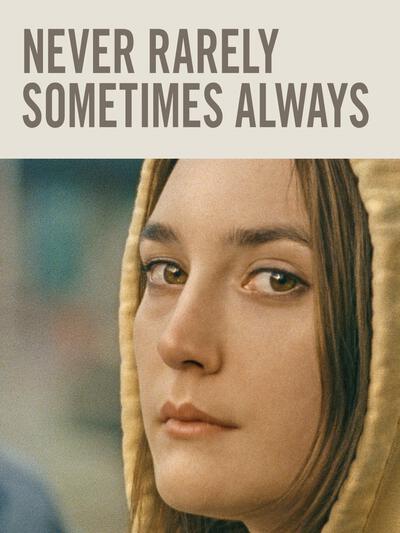 When I think about the characters in Never Rarely Sometimes Always—bundled up in jackets, half sleeping on the train—I’m reminded of that haunting bookend image. It’s a long way from 19th century Oregon to present New York City, but the same cruel calculation remains an all-consuming force. We still accommodate or discard based on a reductive sense of value. Autumn, the film’s protagonist, is among the too-easily discarded. 17 years old, pregnant, and more or less broke, she’s perpetually been treated like a nuisance. And she seems to have internalized that message—prone to lengthy bouts of silence, turning inward as an instinct. So in those moments when a bureaucratic hurdle would threaten her resolve, it’s her older cousin Skylar who needs to keep her pressing onward. Which isn’t to imply that Skylar’s particularly happy to be needed. What moves me about their friendship is that it isn’t sentimental. Skylar isn’t a shoulder to cry on or a comforting distraction. Rather, she’s an advocate, insisting on Autumn’s agency even to the point of annoyance. She can’t dictate Autumn’s choice, but she can nudge her towards some clarifying questions—and to a room where she’ll be granted space to answer.
When I think about the characters in Never Rarely Sometimes Always—bundled up in jackets, half sleeping on the train—I’m reminded of that haunting bookend image. It’s a long way from 19th century Oregon to present New York City, but the same cruel calculation remains an all-consuming force. We still accommodate or discard based on a reductive sense of value. Autumn, the film’s protagonist, is among the too-easily discarded. 17 years old, pregnant, and more or less broke, she’s perpetually been treated like a nuisance. And she seems to have internalized that message—prone to lengthy bouts of silence, turning inward as an instinct. So in those moments when a bureaucratic hurdle would threaten her resolve, it’s her older cousin Skylar who needs to keep her pressing onward. Which isn’t to imply that Skylar’s particularly happy to be needed. What moves me about their friendship is that it isn’t sentimental. Skylar isn’t a shoulder to cry on or a comforting distraction. Rather, she’s an advocate, insisting on Autumn’s agency even to the point of annoyance. She can’t dictate Autumn’s choice, but she can nudge her towards some clarifying questions—and to a room where she’ll be granted space to answer.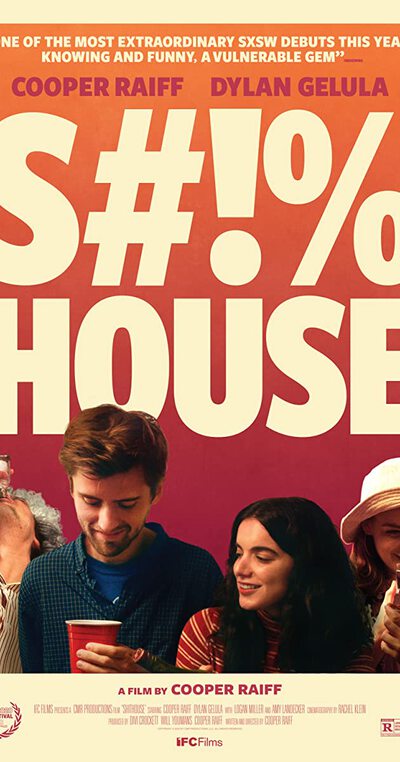 Maggie thinks the point of college is to discover who you are. Alex adds a corollary: it’s to support each other in the process. That tension between independence and codependence, personal identity and group identification, is the emotional crux of Shithouse. It also happens to be the emotional crux of growing up. After 18 years of life primarily steered by someone else, you suddenly find yourself miles from home, alone behind the wheel. What do you do? Move too far in either direction and it loops back on itself. Camp up in your dorm room, walled off from the universe, and you’ll postpone any chance at self-discovery. Push your social life to the breaking point with an endless string of parties, and you’ll never feel more thoroughly alone. Meet someone who sharpens you, engage in “life-changing” conversation, and in the glow of wine and streetlamps you’ll catch a glimpse of who you are. Irreparably blow it the following morning as want curdles to obsession, and you’ll get a clearer picture of the mess that’s left to fix. A girl is not a savior; a crowd is not a family; loneliness is not a badge of philosophic rigor. Through a lifetime of trying and failing and wildly overcompensating, a real self will come into view. Even still, you’ll always look back fondly on those nights of aimless searching. On that time when all of “you” hung in the balance.
Maggie thinks the point of college is to discover who you are. Alex adds a corollary: it’s to support each other in the process. That tension between independence and codependence, personal identity and group identification, is the emotional crux of Shithouse. It also happens to be the emotional crux of growing up. After 18 years of life primarily steered by someone else, you suddenly find yourself miles from home, alone behind the wheel. What do you do? Move too far in either direction and it loops back on itself. Camp up in your dorm room, walled off from the universe, and you’ll postpone any chance at self-discovery. Push your social life to the breaking point with an endless string of parties, and you’ll never feel more thoroughly alone. Meet someone who sharpens you, engage in “life-changing” conversation, and in the glow of wine and streetlamps you’ll catch a glimpse of who you are. Irreparably blow it the following morning as want curdles to obsession, and you’ll get a clearer picture of the mess that’s left to fix. A girl is not a savior; a crowd is not a family; loneliness is not a badge of philosophic rigor. Through a lifetime of trying and failing and wildly overcompensating, a real self will come into view. Even still, you’ll always look back fondly on those nights of aimless searching. On that time when all of “you” hung in the balance.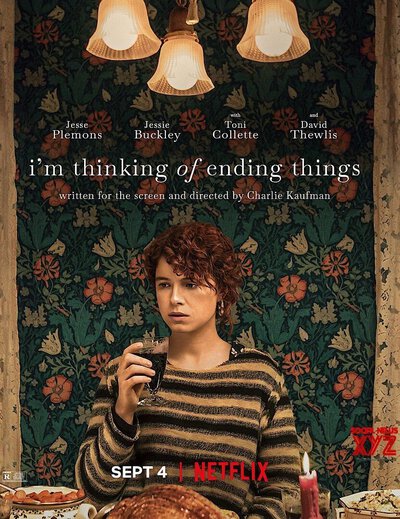 Want curdles to obsession. There’s little I can say about I’m Thinking Of Ending Things without spoiling the experience, but that hard truth Alex learns is at its root. We are so desperate to be loved, recognized, included—and desperation can grow toxic, regardless of intent. A chilly echo chamber, an infinite regress. Whether seeking validation in a high paying career or a top shelf degree, a stirring creative project or a scorched earth criticism. Whether marching in support of some bloated sense of “Great”-ness, or sneering from the sidelines, lobbing dry, ironic stones. “Whether you have a wife or just a wife-shaped loneliness waiting for you.” We need other people—real ones—to keep that need from caving in on itself; to challenge us, defy our basest expectations. Alex and Maggie’s theories are both right, in a sense. A healthy independence requires some network of support: external voices reiterating our authentic selves to us.
Want curdles to obsession. There’s little I can say about I’m Thinking Of Ending Things without spoiling the experience, but that hard truth Alex learns is at its root. We are so desperate to be loved, recognized, included—and desperation can grow toxic, regardless of intent. A chilly echo chamber, an infinite regress. Whether seeking validation in a high paying career or a top shelf degree, a stirring creative project or a scorched earth criticism. Whether marching in support of some bloated sense of “Great”-ness, or sneering from the sidelines, lobbing dry, ironic stones. “Whether you have a wife or just a wife-shaped loneliness waiting for you.” We need other people—real ones—to keep that need from caving in on itself; to challenge us, defy our basest expectations. Alex and Maggie’s theories are both right, in a sense. A healthy independence requires some network of support: external voices reiterating our authentic selves to us.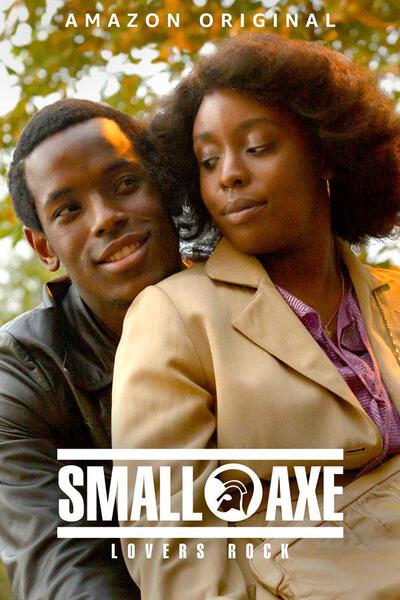 Lovers Rock might be the purest expression of precisely what I miss. It’s an act of surrender, of intentional forgetting. People gathering in a crowded room from all possible stations, setting down their burdens to simply be alive, together. A voice melding into a choir. A bass you could feel in your chest. An outside world which doesn’t fade out entirely—Babylon sirens blending into the upstroke. It’s that feeling of letting go, of having permission to abandon, of forfeiting the need to make any conscious choice. It’s the dinner that balloons into four hours of stories, the joke that isn’t funny which leaves everyone in tears, the audience shouting lyrics till they can barely hear the band. It’s the stuff that never fits inside the confines of a Zoom call, no matter how creative our attempt. It’s the magic of kinetic energy: bodies packed into a tiny space, unscheduled, sharing heat.
Lovers Rock might be the purest expression of precisely what I miss. It’s an act of surrender, of intentional forgetting. People gathering in a crowded room from all possible stations, setting down their burdens to simply be alive, together. A voice melding into a choir. A bass you could feel in your chest. An outside world which doesn’t fade out entirely—Babylon sirens blending into the upstroke. It’s that feeling of letting go, of having permission to abandon, of forfeiting the need to make any conscious choice. It’s the dinner that balloons into four hours of stories, the joke that isn’t funny which leaves everyone in tears, the audience shouting lyrics till they can barely hear the band. It’s the stuff that never fits inside the confines of a Zoom call, no matter how creative our attempt. It’s the magic of kinetic energy: bodies packed into a tiny space, unscheduled, sharing heat.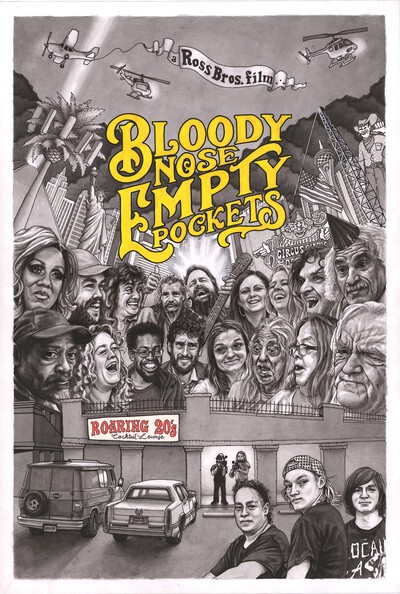 To the barflies who populate Bloody Nose, Empty Pockets, motion blur is more than a temporary reprieve. It’s the fundamental texture of living. You’ve met them, I’m sure—the guy who slurs through his last three marriages on an endless flight delay, the woman who roars with gravely laughter before you’ve even hit the punchline. But have you ever really seen them? Beyond the faux philosophic discussions and liver defying habits, lies an all-too-human yearning to unburden. An eagerness to be made vulnerable, to know and be made known, to thoroughly dissolve into a crowd. Like the characters in Another Round, they elicit an empathy that runs deeper than any judgment. Perched behind the counter for their Roaring last hurrah, it’s easy to get swept up in the afterglow.
To the barflies who populate Bloody Nose, Empty Pockets, motion blur is more than a temporary reprieve. It’s the fundamental texture of living. You’ve met them, I’m sure—the guy who slurs through his last three marriages on an endless flight delay, the woman who roars with gravely laughter before you’ve even hit the punchline. But have you ever really seen them? Beyond the faux philosophic discussions and liver defying habits, lies an all-too-human yearning to unburden. An eagerness to be made vulnerable, to know and be made known, to thoroughly dissolve into a crowd. Like the characters in Another Round, they elicit an empathy that runs deeper than any judgment. Perched behind the counter for their Roaring last hurrah, it’s easy to get swept up in the afterglow.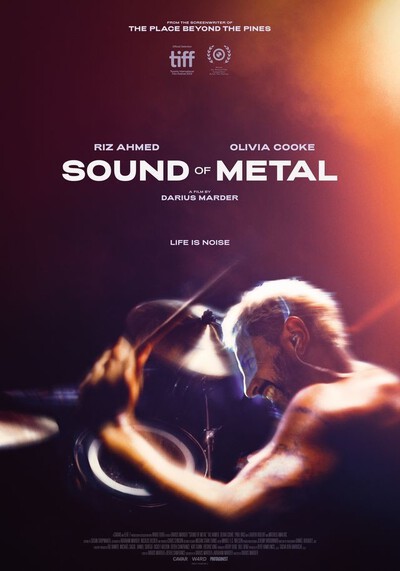 Could there be a more fitting complement to this year than Sound of Metal? Over the course of a single day, Ruben loses virtually everything that defines him: the vintage record player, the whir of his blender, the thrill of live performance, the whisper of “goodnight.” He’s lost his hearing, yes, but more importantly he’s lost the noise. If his former life as an addict was defined by a singular want, noise offered him the promise of plurality. A divided attention, a translucent swath of “focus,” a sludge of stimuli dense enough to dampen any urge. Dissolved into the chaos of a Friday night set, Ruben could be everywhere and nowhere. Now he can only be here: a place where stillness is the default, and listening a clear and conscious choice. All system rebel on that first early morning, alone with his coffee and his donut and his thoughts. But slowly he weans himself off of the chatter. He grieves his old life and learns to carve out a new one, discovering new gifts in its absence.
Could there be a more fitting complement to this year than Sound of Metal? Over the course of a single day, Ruben loses virtually everything that defines him: the vintage record player, the whir of his blender, the thrill of live performance, the whisper of “goodnight.” He’s lost his hearing, yes, but more importantly he’s lost the noise. If his former life as an addict was defined by a singular want, noise offered him the promise of plurality. A divided attention, a translucent swath of “focus,” a sludge of stimuli dense enough to dampen any urge. Dissolved into the chaos of a Friday night set, Ruben could be everywhere and nowhere. Now he can only be here: a place where stillness is the default, and listening a clear and conscious choice. All system rebel on that first early morning, alone with his coffee and his donut and his thoughts. But slowly he weans himself off of the chatter. He grieves his old life and learns to carve out a new one, discovering new gifts in its absence.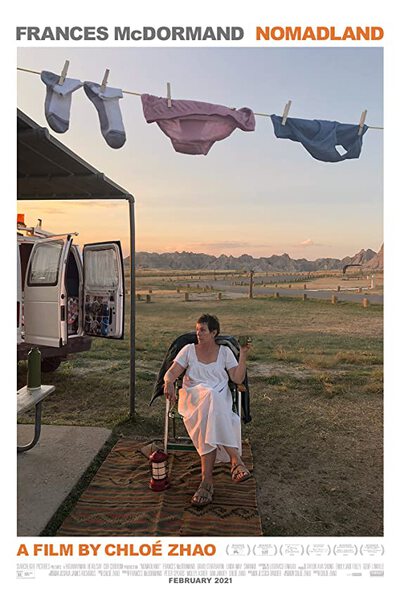 By the time we meet Fern on the road in Nomadland, she has already lost one life and fashioned herself a new one. Though in a literal sense, her story is flipped: Fern grieves the loss of stillness via therapeutic motion. With the death of her husband and the closure of her workplace, she no longer sees any reason to stay anchored. So she drives, and drives, and drives. Living in a van and working seasonal gigs, she is tethered to nowhere and no one. But what she’s seeking in an open road is the same as Ruben in his kitchen. Absolute solitude. A sufficiency of being. The ability to survive without the bustle. As she weaves from job to job through the American Midwest, it’s not always clear exactly where she’s headed. Some nights it seems like she’s fleeing from something; some nights it seems like she’s found it. There’s no perfect way to meditate, no ideal way to grieve. But in the experience of watching her, there’s no mistaking the directive: an urge to turn down the volume, soak in the landscape, embrace our private wilderness and be.
By the time we meet Fern on the road in Nomadland, she has already lost one life and fashioned herself a new one. Though in a literal sense, her story is flipped: Fern grieves the loss of stillness via therapeutic motion. With the death of her husband and the closure of her workplace, she no longer sees any reason to stay anchored. So she drives, and drives, and drives. Living in a van and working seasonal gigs, she is tethered to nowhere and no one. But what she’s seeking in an open road is the same as Ruben in his kitchen. Absolute solitude. A sufficiency of being. The ability to survive without the bustle. As she weaves from job to job through the American Midwest, it’s not always clear exactly where she’s headed. Some nights it seems like she’s fleeing from something; some nights it seems like she’s found it. There’s no perfect way to meditate, no ideal way to grieve. But in the experience of watching her, there’s no mistaking the directive: an urge to turn down the volume, soak in the landscape, embrace our private wilderness and be.